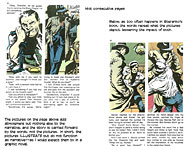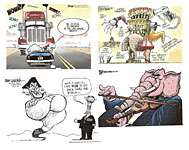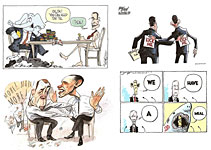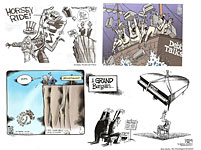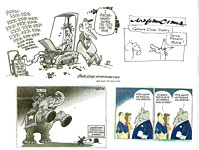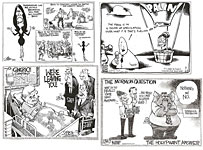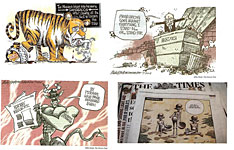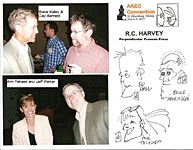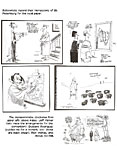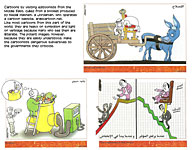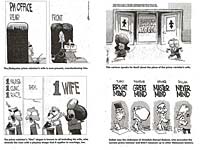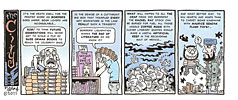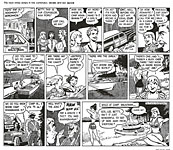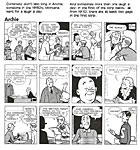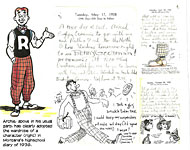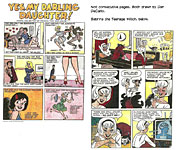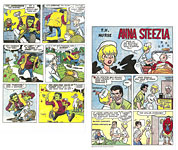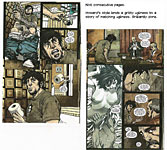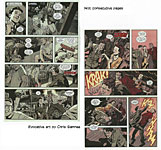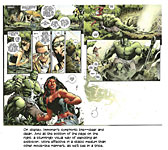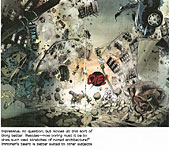 |
||||||||||||||||||||||||
Opus 281 (August 13, 2011). In the aftermath (you should pardon the expression) of the Big Budget Deal and the self-indulgent recklessness of the Congress in shillyshallying around about the fake debt ceiling crisis, we expend more than our usual allotment of commentary on matters political this time. Excessive, you’ll agree, but my disgust is so profound that it knows no limit—a expression I make palpable (pardon the expression) in the plethora of logorrhea that ensues in our Editoonery Department. Should you want to skip over the blatherskite to get to the cartoons and the comments they provoke simply as cartoons, we’ve made that reasonably easy by marking the beginning of each new cartoon commentary section with AN ALL CAP INTRODUCTORY PHRASE. So you can scroll through the whole mess, stopping only when you run up against a CAPITAL IMPASSE. Ire at Congress is not the only topic we cover in this voluminous opus. The Big Story is our report on the machinations at St. Petersburg, Florida, during the annual meeting of the Association of American Editorial Cartoonists (AAEC—of which, I should add, I am not only a member but an officer, secretary-treasurer). We also review a couple of the spate of Archie books now appearing in bookstores—The Classic Newspaper Strips, 1946-1948; and Craig Yoe’s Archie: A Celebration of America’s Favorite Teenagers and his Archie Madhouse. Funnybooks reviewed include The Cape (the second No. 1 and the first No. 1), Jonah Hex No. 69, Captain America and Bucky No. 620, and the first four issues of Fear Itself. And more, much more—including an illustrated explanation of why Steranko’s Red Tide is not a graphic novel.
BUT BEFORE WE
HEAD YOU OFF at the aforementioned impasse with a detailed list of other topics
being covered this time, in yet another in our ongoing celebrations of the Year
of the Rabbit, here, in close proximity, is ol’ Cahoots hisownself, introducing
the logo of a new art gallery, now open in Osaka, Japan, run by your friendly
R&R webmaster, Jeremy Lambros. “Kurofune” means black ship in Japanese. It refers to the pitch-painted foreign ships that opened Japanese ports for trade with other countries. Now the word is used by Japan to describe foreign styles or new types of goods coming from outside the country. And that’s what Kurofune will be doing—bringing in artists, illustrators, designers and cartoonists from Europe and the Americas. “We want to give artists opportunities to have their work seen in Japan,” Lambros says. “Our gallery features original artwork, prints, books, toys and other goods.” Gallery Kurofune is made up of gallery space for rotating exhibits and a shop for selling books, cards, shirts and lower priced goods. If you’re an artist, illustrator, designer or cartoonist and you think your work might do well at Gallery Kurofune, contact Lambros here for more details. And have some low resolution samples of your work available for review.
AND NOW, at last, we come to the usual painstakingly detailed rundown preview of this opus’s content. We list the coverage at the onset of each Opus so that you can find the topics that interest you and, with the list as guide, skip over the topics that don’t interest you at all. (We don’t, really, expect you to read all of this Vastly Interesting Stuff.) With that advisory upper most in your mind, here’s what’s here, in order, by department—:
NOUS R US Marvel Gets Rights to Kirby-Lee Creations Raw Sex at Archie (Sexism, I Mean–Sexism) When Parody and Satire Become Illegal San Diego Union-Tribune Back in Court At the Movies: Captain America and the Smurfs Raw Sex with the Smurfs Steranko and the First Graphic Novel?
EDITOONERY More Than a Dozen Editoons on the Budget Deal Fiasco Plus Rants on the Whole Disgraceful Brouhaha And the Murdoch Mess
Layoff and Retirement Diminish the Ranks Some More
AAEC ANNUAL MEETING IN FLORIDA Prez Urges Action Not Just Words (and Pictures) —and Writes a Scathing Letter and Delivers a Stirring Speech Next Year in Washington: A Public Display
Spotlight on Malaysian Cartooner Zunar
Persiflage and Furbelows Remembering Where Wise Men Fish As Borders Closes
BOOK MARQUEE Mad Fold-In Collection
BOOK REVIEW Archie Tomes— The Classic Newspaper Strips, 1946-1948 A Celebration of America’s Favorite Teenagers (with another brief examination of the evidence about who created Archie) Archie’s Madhouse
FUNNYBOOK FAN FARE The Cape No. 1 (again) Jonah Hex No.69 Captain America and Bucky, No. 620 Fear Itself
PASSIN’ THROUGH Sam Norkin Lee Ames
Our Motto: It takes all kinds. Live and let live. Wear glasses if you need ’em. But it’s hard to live by this axiom in the Age of Tea Baggers.
And our customary reminder: don’t forget to activate the “Bathroom Button” by clicking on the “print friendly version” so you can print off a copy of just this installment for reading later, at your leisure while enthroned. Without further adieu, then, here we go—
NOUS R US Some of the News That Gives Us Fits
Marvel
Gets the Rights to Kirby-lee Creations In 2009, Kirby's heirs sent Marvel and Disney 45 notices of a plan to reclaim copyrights in a series of Marvel comics that were published from 1958 to 1963. The comics included issues of The Amazing Spider-Man, The Avengers, Sgt. Fury and His Howling Commandos and others. In her ruling, however, Judge McMahon said the notices "did not operate to convey any federally protected copyrights." The court's action, as reported by Michael Cieply at the New York Times, removed any doubt that might have impaired Disney's ability to move forward with exploitation of the properties in full faith that they control all rights to the Marvel Universe. In the 50-page decision, McMahon spelled out what was really at stake very early when she wrote: "At the outset, it is important to state what this motion is not about. Contrary to recent press accounts, this case is not about whether Jack Kirby or Stan Lee is the real 'creator' of Marvel characters, or whether Kirby (and other freelance artists who created culturally iconic comic book characters for Marvel and other publishers) were treated 'fairly' by companies that grew rich off the fruit of their labor. It is about whether Kirby's work qualifies as work-for-hire under the Copyright Act of 1909, as interpreted by the courts, notably the United States Court of Appeals for the Second Circuit. If it does, then Marvel owns the copyright in the Kirby works, whether that is 'fair' or not. If it does not, then the Kirby heirs have a statutory right to take back those copyrights, no matter the impact on recent corporate acquisition or on earnings from blockbuster movies made and yet to be made." In the end, the judge agreed with Marvel's version of the events, “that the Kirby works were indeed works for hire." Comicbookresources.com’s Kiel Phegley quoted legal expert Michael L. Lovitz of Lovitz IP Law, who explained: "Essentially, the Kirby heirs were unable to overcome the presumption that the works were 'work-for-hire' because they were created at Marvel's instance and expense." Lovitz noted that a key factor in the decision was "testimony that Kirby 'didn't do work on spec, he was getting paid by the page' and while he would pitch ideas, he didn't draw anything without approval or an assignment." McMahon cited statements made by Kirby before his death to support her finding that his creations must remain Marvel's property. Quoted by Larry Neumeister at the Washington Examiner, she noted that he said in a 1986 affidavit that he did his work at a time when it was common practice that vested ownership of his creations belonged to the company that paid him to draw. She said he also signed a written agreement in the spring of 1972, well after the creation of the characters, admitting that he was not entitled to retain ownership of the work. How this decision may affect other pending legal action against Warner Bros over the rights to Superman claimed by Jerry Siegel’s heirs remains to be seen.
Sexism at Archie ICv2.com reported that Archie Comics Publications filed suit in early July against Co-CEO Nancy Silberkleit accusing her of raving sexist behavior—among other things, barging into a meeting in 2009, pointing in succession at each of four men in the room, and yelling “Penis, penis, penis, penis.” Then she stormed out of the room. She supposedly repeated the anti-phallic outburst again in 2010 and followed it up by exclaiming, “My balls hurt.” Employees report other instances of bullying and sexual harassment. One asserted that, on another occasion, he heard Silberkleit say: “All you penises think you can run me out.” Archie Comics is seeking a court injunction that would keep Silberkleit away from the office and stop her from representing the company at the San Diego Comic-Con. Silberkleit, a former art teacher, joined the Archie management team after the death of her husband (and Archie partner) Michael in 2008, and she was named Co-CEO (with Jon Goldwater) in July of 2009. Archie Comics is the only Golden Age comics company to remain in the hands of the heirs of the original founding families. The partners managed to get along through two generations, said ICv2.com, but this lawsuit could signal the end of an era at Archie. According to TMZ.com, “Archie claims it hired an outside firm to investigate the allegations, and the company recommended Archie cut ties with Nancy asap.” I have no inside information, of course, but Silberkleit’s alleged outbursts strike me as being highly satirical, not the actions of a mentally disturbed person but a calculated counter-sexism campaign. Soon after coming into the company, Silberkleit complained to Steve Duin at the Portland Oregonian about the resistance she met from the entrenched old boy network, so there may well be another side to the “penis taunting” incidents, which will undoubtedly come out if the suit goes to trial. In terms that comics fans would understand, Duin reported in 2010, “she was surrounded by Jugheads with a mean streak, Archies without the good intentions and Reggies armed with full-length mirrors, not the pocket varieties.” "I'm a mother coming into a very male-oriented business," Silberkleit told Duin. "I'm not getting any support. I felt very alone." On August 4, Kevin Melrose at comicbookresources.com reported that Silberkleit was claiming the lawsuit against her is merely "a thinly veneered attempt to smear my name and gain complete corporate control" for her counterpart Jon Goldwater. The lawsuit seeks to bar her from the publisher's Mamaroneck, N.Y., headquarters and from representing the company at Comic-Con International. A judge allowed her to return to work and attend the San Diego conclave, but she wasn’t permitted to talk to vendors. She is listed in the Con program at a session entitled “Comics Mobile,” sponsored by Comics Academy, which exists to foster an appreciation of comics and graphic novels in academia. Silberkleit (it sez here) “will discuss how to investigate the merits of comic books in academia.” Alas, I didn’t attend, so I don’t know if she spoke to any vendors that might have been attending the session. Or not. Nor do I know if she yelled penis randomly and pointed around the room. The Journal News reports that Silberkleit denies the allegations against her, claiming that Goldwater, son of Archie Comics co-founder John L. Goldwater, is a chauvinist who's attempting to drive her out of the company. "He has called me ‘stupid,' a ‘moron,' and ‘despicable,'" Silberkleit said in an affidavit filed in late July. "In the presence of others he has told me to ‘shut up' and ‘why can't you be sweet, nice and quiet like a lady?'" She accuses Goldwater of making corporate decisions without her, canceling a children's literacy tour without telling her, and turning employees against her. "Mr. Goldwater long ago and repeatedly has told some employees and also people within the industry that he would get rid of me one way or the other," Silberkleit wrote. Her attorney has filed a motion to dismiss the company's lawsuit. A hearing is set for Aug. 16 in New York Supreme Court in Manhattan.
When Parody and Satire Become Illegal In what a casual observer might dub a transparent attempt to muzzle a satirical critic, a prosecutor in Renton, Washington, wants to send an anonymous Internet cartoonist to jail for embarrassing the police department, according to David Edwards, reporting at rawstory.com. City prosecutors are basing their case on a broad cyberstalking law that makes it a crime to “harass … torment, or embarrass” a person with “any lewd, lascivious, indecent, or obscene words, images, or language.” Cloaked in this legalistic balderdash, city officials claimed that the purpose of a series of nine videos posted on YouTube “was to embarrass, torment, and harass specific members of the police department and other city employees”—thus, qualifying the videos as cyberstalking crimes. In a further giggle on the topic, the official explanation for the action continues: “Often, law enforcement is accused of failing to investigate incidents of misconduct ...” But not, we realize, in Renton, Washington, where officialdom is ever on the alert. The Renton police department has, it seems, been stewing about the videos for months, and when it was learned that the cartoonist’s online pen-name is Mrfuddlesticks, the police got a local judge, King County Superior Court James Cayce, to issue on cyberstalking grounds a search warrant to Google (owner of YouTube) to discover the identity of the wayward cartooner. “The
cyberstalking angle doesn’t pass the laugh test,” cyber-law expert Venkat
Balasubramani told local tv channel KIRO/7' s Chris Halsne. “It’s a serious
stretch and I’d be surprised if somebody looked at it and realistically thought
these acts actually fit the statute and we could make somebody criminally
liable. I think they were trying to get at the speaker and they looked around
for a statute that shoehorned their conduct into and sent that to Google and
said ‘turn over the information.’” One video even seems to address the prosecutor’s obsession with the cartoonist. The
mustachioed cop says: “Is there any reason why an anonymous video, with no
identifying “The reason,” explains the bureaucrat, “is that internal dirt is internal. The department will crucify certain people and take care of others.” While the city wants to criminalize the cartoons, First Amendment rights advocates say the move is an “extreme abuse of power.” What fun. Oh—and the fun got even funnier a couple days later. (The details of this story keep dribbling in over the R&R Internet transom, so we’re dribbling them out to you as fast as we can.) Turns out the Renton Police Department had to scour the countryside to find a prosecutor willing to take on their cause. At the KIRO/7 website, newsman Halsne reported that the King County Prosecutor’s Office declined to take the case, saying there was “insufficient evidence to proceed.” So the cops, rather than admit defeat, approached the city prosecutor, Larry Warren, and convinced him to perform the duty. Confronted by Channel 7's exposure of this connivance, Renton Police Chief Kevin Milosevich was unruffled. Said he: “I would rather err on the side of investigating all complaints [and] alleged criminal misconduct than risk failing to investigate a crime that’s been reported.” Ever diligent. Then, suddenly, Judge Cayce ordered a stay on the search warrants he’d previously authorized. He was provoked in this direction by Seattle attorney Harish Bharti, who, according to seattlepi.com, filed a motion to quash the warrants because the police had obtained the warrants “in bad faith” by failing to disclose pertinent information—namely, that the police had gone “prosecutor shopping” after the county prosecutor had decided there was “insufficient evidence” to pursue the matter. Said Bharti: “This abuse of police power is beyond belief. The cartoonist and everybody else have a constitutionally protected right to be anonymous and to exercise their free speech and expression.” When the stay ordered was issued on August 9, Bharti claimed “a victory for our free-speech rights.” But city attorney Warren says the stay is but a momentary halt, claiming that the judge was in the grip of a scheduling conflict and instructing the police to put any materials they’d obtained [from the warrants so far] in a sealed envelope to await yet another court decision. The identity of the mystery cartoonist still hadn’t been revealed as of August 10. The videos, meanwhile, are no longer on YouTube. But one of them, uploaded under the account name “whothehellispenny,” exists at extranormal.com, reports Alan Gardne at DailyCartoonist.
San Diego Union-Tribune Back in Court From Alan Gardner at DailyCartoonist: New Orleans Times-Picayune editorial cartoonist Steve Kelley is going back into court to resume the legal action against his former employer, the San Diego Union-Tribune: an appellate court reinstated the case after it was thrown out in 2009. Kelley alleges that the Union-Tribune threatened to fire Steve Breen, Kelley’s successor at the U-T, if he continued to collaborate with Kelley on the comic strip Dustin, still in development at the time. Breen eventually pulled out of the partnership, and Kelley sued the paper on three counts: intentional interference with contractual relations; intentional interference with prospective economic advantage, and unfair competition. With a new drawing collaborator, Florida Today’s editoonist Jeff Parker, Dustin debuted nationwide in early 2010 and now appears in about 400 newspapers, a success by any measure. I’m pretty sure the U-T was acting out of pure vindictiveness: Kelley and the paper parted under less than convivial circumstances several years ago. The cartoonist, a twenty year veteran at the paper, was sacked in 2001 after an altercation with one of his editors, who mistakenly accused Kelley of “sneaking” into print a cartoon that had not been approved. While the first version of the cartoon had been rejected, Kelley had corrected the drawing, removing his editor’s objections. When the cartoon was ready to turn in, the editor was no longer around, so Kelley left the cartoon with a page designer. The editor subsequently discovered the cartoon and yanked it while it was in the final production stage, accusing Kelley of trying to pull a fast one, thereby precipitating the ruckus that ended with Kelley out of a job. That’s the gist of it, but the incident is rehearsed with full details in Opus 62, wherein it is clear to me (being a biased observer and friend of Kelley) that Kelley was more in the right than his volatile boss, a verdict supported, later, by the paper’s spiteful attempt to sabotage Kelley’s comic strip aspirations by undermining his partnership with Breen.
AT THE MOVIES The First Avenger and Those Li’l Blue Buggers Director Joe Johnson’s “Captain America” took box office honors on its opening weekend, which, in unlikely coincidence, took place while the Sandy Eggo Comic-Con was transpiring. With 130,000 comics fans on the lower left coast, it strains credulity that there were enough funnybook geeks still loose elsewhere in the world to buy tickets registering $65.1 million, but these things happen. And it’s good that they do. (Still, I’m starting to think the comic book superhero movie has about run its course. Even though a sturdy raft of them are still in production for future summer blockbusters, flick fads of this sort eventually run out of steam and fade away. And it might be just about that time for the spandex crowd.) Owen Gleiberman at Entertainment Weekly found the star-spangled superhero movie “stolidly corny, old-fashioned pulp fun,” as ringing an endorsement as anyone might want. At the Orlando Sentinel, Roger Moore thought the movie “has so much business to take care of that, frankly, it’s astounding that Johnson is able to take care of it all—and with style.” The “business” at issue involves connecting a World War II hero to modern times and tying it all into the rest of the Marvel Universe movies that are a-borning. But Johnson does it, Moore avers, creating fun with a “light, clever and deftly balanced adventure picture.” And, speaking of revisiting the past, scroll on down to Funnybook Fan Fare for a fast glimpse at Captain America and Bucky.
“THE SMURFS” blue away all but one of the competition the next weekend: “Captain America” slipped to third place, and Peyo’s woodland dwarfies unexpectedly finished in a dead heat with “Cowboys & Aliens.” Most reviews I saw liked “The Smurfs” with its combination of live and animated actors, but Sean O’Connell in a special to the Washington Post wasn’t convinced: Raja Gosnell “relies on cutting-edge CGI and unnecessary 3-D wizardry to transport the pint-sized heroes of our childhood from their native enchanted forest to a noisy New York City” where they prove neither exciting nor entertaining. O’Connell says he liked the Smurfs just fine when he watched them on tv as a 7-year-old, and, sure enough, he finds nothing in the big-screen incarnation that would appeal to anyone who wasn’t preadolescent. At the Village Voice, Eric Hynes takes off in another direction altogether by noting evil wizard Gargamel’s snide observation about “an elephant that’s stalked the Smurf room for more than half a century: Papa Smurf, the white-bearded, Marxian patriarch of blue-faced laborers, has 99 sons and just one daughter. ‘Nothing weird about that, no, no,’ Gargamel cracks,” alluding, not to subtly, to the “tantalizing gender disparity” in the Smurfs’ commune. “Since the dawn of Internet chat rooms,” Hynes continues, “when children of the 1980s grew into consumers, sharers and purveyors of pop-cult perversities, two paths have been pondered for the Smurf milieu: either the little village people are gay, or Smurfette is a very busy gal. Unsurprisingly,” he goes on, “the majority of the smufsmut, like most agro-hetero porn, goes for the gang bang.” Yes, the Smurfs seem wholly occupied in other pursuits, but that doesn’t retire a persistent question: “But,” people ask, “do Smurfs have… you know… sex?” The answer, wrote Salvatore Cavaleri at alt.sex.stories in April 1995, “is an emphatic and resounding yes! And why shouldn’t they? They’re people, too. What most people don’t know is why Smurfs are blue. Well, the reason is because Smurfs have sex only once a year. Face it: if you had sex only once a year, you’d be blue, too. Once a year, in the Smurf village, flags and banners fly happily in the breeze, proclaiming that the day of the annual Smuckfest has arrived. ... In the middle of town, Papa Smurf gives a brief speech explaining the origin of the Smuckfest: ‘Smucking one day a year will help us identify any diseases we may transmit to one another, and keep them from spreading to the animals in the forest,’ declaimed Papa Smurf. ‘Besides, it will give Smurfette a chance to rest.’ “Yes!,” Cavaleri continues, “Smurfette must rest. For, as everyone knows, Smurfette is the only female Smurf in the village, and after a full day of having vigorous, rabid sex with two hundred cunt-crazed little blue men, she needs a break.” For Cavaleri’s vivid, no adjective barred description of a Smuckfest, beam up to hoboes.com/FireBlade/Politics/Smurfs/ And, just for the fun of it, don’t neglect Hynes at villagevoice.com/2011-07-27/film/working-blue-smurfsex-from-peyo-to-porn Meanwhile, for a dose of the traditional blue-skinned charm, you needn’t prowl the Web: Papercutz is still publishing the authentic Peyo product in all its blue-skinned charm; visit papercutz.com
Jim Steranko, Will Eisner, and the First Graphic Novel At a panel during the Sandy Eggo Comic-Con last month, Hall of Fame comics creator Jim Steranko continued to maintain that he launched the graphic novel in 1976 with Red Tide, a noir detective tale that is poised for reprinting (with an in-the-works sequel) by Dark Horse. Reporting the event, Jason Strykowski at comicbookresources.com said that “while Will Eisner is widely credited as the father of the graphic novel form, Steranko begged to differ, saying he's ‘a little disappointed about this controversy that surrounds the graphic novel.’ Of A Contract with God, Eisner's ground-breaking book, Steranko said, ‘I don't really think it can qualify as a graphic novel; it's a collection of short stories.’” After successfully pitching his book to Pyramid Books in late 1975, Steranko faced a tight deadline: “he ate every meal at the drawing board and sealed all the windows of his home to work in the dark. Three months later, he finished,” Strykowski said. "Red Tide was published in '76," Steranko asserted—that is, two years before Eisner’s Contract. “Any questions?" he finished. No questions. Just an observation or two. Some years ago, before the graphic novel had matured its present definition, I suggested that whatever the graphic novel would be, it must incorporate two essential aspects of the cartooning medium if it is to be the same species as comics art. First, the graphic novel must include speech balloons in the pictures because that gives pictures and words concurrence—the illusion that the characters we see are speaking even as we see them, just as we simultaneously hear and see people in real life. Second, the narrative must be “timed” by its breakdown into panels. Narrative breakdown is to comics what time is to life, and it creates pacing as well as duration. The sequencing of panels controls the amount and order of information divulged as well as the order and duration of events. Steranko’s Red Tide (which was actually published as Chandler; “Red Tide” was sort of subtitle) is called a graphic novel in an Introduction by mystery writer Joe Gores, but the book doesn’t meet the criterion I’ve just mentioned. For all its brilliant visual effects, the pace of the story is controlled by the prose text that runs in uniform columns under the pictures. The pictures create the story’s mood, but they almost never add narrative information to the tale: they simply illustrate the story. Although Chandler/Red Tide’s theme is a mature one, in form and function the book is no different from the average illustrated children’s book, as we can see in the accompanying visual aids.
The Dark Horse reprint will preserve Chandler/Red Tide’s original shadow-soaked art with its noir ambiance. The sequel, Steranko said, is “heavily inspired by classic cinematography and will look and feel like frames of a film.” Some pages of the new work will preview in Dark Horse Presents No. 3, out at the end of August; the complete title will be released next year. Strykowski’s report included glimpses of Steranko’s often intriguing biography. “If Steranko's new graphics seem like a magic trick, that may be because Steranko himself is a magician. The inspiration for Michael Chabon's Pulitzer Prize-winning The Amazing Adventures of Kavalier & Clay, Steranko was the kid from the streets who could pick locks and slip out of handcuffs. (In Chabon's book, two comic creators are inspired to create a character they dubbed the Escapist—a superhero who can wriggle his way out of every trap in which he is placed.) “Unlike Chabon's comic heroes,” Strykowski went on, “Steranko also distinguished himself as a street fighter. A wiry kid of 130 pounds, Steranko was frequently beaten to a pulp by a local street gang. He fought back at first by jury-rigging a one-round capacity pistol called a zip gun. Later, Steranko took to the gym and learned brawling techniques from a boxer named Bubbles. “It took a lot of fight for Steranko to land in Stan Lee's office just as his career was getting traction. After talking his way in the door and swaying Lee with a sample of his art, Steranko was granted a comic creator's dream as Lee pointed to a bookshelf of Marvel titles and said, ‘Pick one.’ “Sure that following Jack Kirby on any title was a form of suicide, Steranko opted for a struggling title that had not shown much promise, taking over Nick Fury: Agent of Shield,” which he turned into a spectacular issue-by-issue lesson in how to do comics in striking new ways. Said Steranko a few years later: “I utilized motion picture technique in telling those stories: dynamic symmetry, symbolic montages, point-of-view angle shots, match-dissolve transitions—in sort, any type of shot that would leave a maximum impression on the viewer. The style, which I later came to call Zap Art, became the star of the series.” And in that assessment, Steranko is dead right.
AS FOR THE FIRST Graphic Novel and the invention of the term (by Richard Kyle), whisk over the Harv’s Hindsights for January 2004, “Defining the Graphic Novel.”
IN HIS SYNDICATED COLUMN, Leonard Pitts paused to take note of the nation-wide excitement sparked by Spider-Man’s changing complexion: “Marvel Comics has killed off Peter Parker and replaced him with a new Spider-Man, Miles Morales, who is black and Latino.” Others may get all frothed up about a “radical left turn,” Pitts said, but, as a Spider-Man fan of almost 50 years, he was keeping his cool. “In the first place,” he explained, “this death of Spider-Man takes place in an alternate universe, alternate universes being about as common in comics as sex scandals are in politics. ... [So] the ‘real’ Spider-Man remains Peter Parker.” Debunking various theories that have sprouted across the Web in the wake of Morales’ arrival, Pitts then said: “None of this addresses the underlying cause of all this angst—the nation’s discomfort with its own changing face. America is fast becoming a country where no group will command a numerical majority. Whites will be just another minority group.” True. And as Pitts goes on to say, “The future will come, regardless. A smart nation would prepare for that.”
Fascinating Footnit. Much of the news retailed in the foregoing segment is culled from articles eventually indexed at rpi.edu/~bulloj/comxbib.html, the Comics Research Bibliography, maintained by Michael Rhode and John Bullough, which covers comic books, comic strips, animation, caricature, cartoons, bandes dessinees and related topics. It also provides links to numerous other sites that delve deeply into cartooning topics. Three other sites laden with cartooning news and lore are Mark Evanier’s povonline.com, Alan Gardner’s DailyCartoonist.com, and Tom Spurgeon’s comicsreporter.com. And then there’s Mike Rhode’s ComicsDC blog, comicsdc.blogspot.com and Michael Cavna at voices.washingtonpost.com./comic-riffs . For delving into the history of our beloved medium, you can’t go wrong by visiting Allan Holtz’s strippersguide.blogspot.com, where Allan regularly posts rare findings from his forays into the vast reaches of newspaper microfilm files hither and yon.
Quotes and Mots “It was the most accurate and least factual account of that campaign.”—Frank Mankiewicz in assessing Hunter S. Thompson’s book about the 1968 election. We have long recognized the inherent truth in the assertion about language that two negatives do not make a positive. Lately, however, we can attest to a new truth in the same realm: two positives make a negative. Yeah, right.
EDITOONERY Afflicting the Comfortable and Comforting the Afflicted NOW THAT AUGUST 2 has come and gone, leaving us still here, it is flagrantly apparent that Steve Breen’s vividly imaged pre-August 2 prediction (upper left) about the once and future impending cataclysm is mind-grindingly accurate. Once again, Our Revered Government (ORG) has swerved and averted a national financial disaster. And we’re right back where we’ve been for too long in recent years—standing on the international corner with a tin cup in hand and pitiful appeal in our eyes. Yes, Congress raised the debt ceiling by reaching a compromise through the magic of the usual political hypocrisy that permits politicians to believe passionately in contradictory principles and act upon them all, in succession and sometimes simultaneously. Obama gave up on a “grand bargain”—most conspicuously, balancing draconian spending cuts with tax revenue from the wealthy. And the religious extremists on the right gave up cuts in entitlement programs. And with the latter forfeit, the Tea Baggers displayed a flexibility in principle that they have so far demonstrated only by abandoning their opposition to pork barrel politics and big-spending government. Yes, the Tea Baggers are no different than any other politician sent to Washington. Last December, when the newly elected Tea Baggers were just setting up shop in the nation’s capital, Dana Milbank at the Washington Post observed: “It was probably inevitable that the Tea Party activists/voters would be betrayed, but the speed with which congressional Republicans have reverted to business-as-usual has been impressive.” After loudly condemning lobbyists and special interest groups for “throwing money at the feet of a member of Congress,” South Dakota’s Kristi Noem hired as her chief of staff a person who previously served on the staff of a lobbying firm. And at least a dozen other incoming Republican lawmakers did the same. A watchdog group, Tea Party Patriots, reported in December that the Republican tax compromise violated “no fewer than five provisions of the Republicans’ campaign Pledge to America,” yet when the Senate held a crucial cloture vote on the compromise, it passed 83-15. And the same utter disregard for loudly touted small government principles continues. “Tea Party freshmen who were swept into office largely based on their pledge to end congressional pork are apparently hogging the trough,” saith the conservative Fellowship of the Minds. Capital Hill Blue continues: “While talking the big plan to be fiscally responsible, the Republican freshmen have packed a huge $553 billion spending bill with millions of pet defense projects for their home districts. Yep. Pork barrel is still alive in the halls of Congress, and the pigs at the trough are the ones voters sent to Washington to end the wasteful practice. ... For example, freshman GOP Rep. Bobby Shilling put in $2.5 million for weapons and munitions advanced technology for the Quad City Manufacturing Lab at Rock Island Arsenal, which just happens to be in his district. During his campaign against Democrat Phil Hare last year, Shilling criticized Hare for adding money to defense budgets for the same facility. GOP frosh Vicky Hartzler of Missouri packed the bill with $20 million for ‘mixed conventional load capability for Air Force bombers’ for Whitman Air Force Base in her district. She backed the GOP moratorium on earmarks during her campaign; now she says she didn’t think the moratorium applied to defense spending.” But the most laughable wriggle was simply nomenclature. DailyKos, referencing the Associated Press, reported “that despite banning earmarks, Tea Party backed Republicans are planning to quietly funnel millions of dollars to pet projects in their home districts by using a mechanism they call ‘member requests.’” And how do “member requests” differ from earmarks? Member requests carry “a disclaimer that says a decision to spend these budgetary requests must be based on competition or merit.” Competition we understand; but who determines “merit”? You only need one guess. I’m not so sure that earmarks—that is, “congressional directed spending”—is inherently evil: it permits members of Congress to say how money should be spent in their districts, and if they don’t say how, then the executive branch gets to make the determination. So maybe “directed spending” is okay. What’s not okay, however—and this is the abuse that anti-earmarkers attack—is adding spending allocations to bills in secret, in the dead of night. It’s the lack of transparency encouraged by the process that is the evil. And I don’t see that the new requirement that money must be allocated through a competitive selection procedure or “merit” is any more transparent than the previous boondoggle. That, however, is beside the point I’m making at the moment. As DailyKos noted: “Republicans spent 2010 arguing that any congressional directed spending was the equivalent to corruption, no different than stealing money from taxpayers. One of their first official actions after winning the election was to pledge that they would ban earmarks. Yet here we are less than six months later and earmarks are alive and well, just with a different name.” Moreover, it seems the same Tea Baggers who won election by railing against big government and runaway spending are now participating in big government by adding more spending to bills and earmarking the money for specific constituencies in their home districts. So when they all chime in together in a resounding chorus insisting upon no more spending, they are revealed, fore and aft, as hypocrites who have graduated from the farm clubs to the big leagues in a scant few weeks. And all that talk about a balanced budget amendment? It’ll never happen. To work under the restraints of a balanced budget amendment would hamper every politician in achieving his purpose in life—to be re-elected. Might not be a bad idea, though: if we’d had a balanced budget amendment, GeeDubya wouldn’t have been able to launch two wars without paying for them.
AND WHENEVER YOU COME a clutch of capital letters like this, following immediately after a break in the typography, you know we’re changing the subject from rant to review, from hysterical palaver about misbegotten politicians to the high art of political cartooning. So if you don’t want to waste your time with our gagging over so-called government, whenever you come to a spate of it, you can quickly skip it by scrolling down to the next bunch of capitals. And now, about the high art of political cartooning—: Moving clockwise in our visual aid, we come to Pat Bagley’s visual metaphor for the legislation ORG adopted in its last minute swerve. The picture bellows Golderbergian contraption loud and clear: we don’t even need to pretend to understand how it works. We don’t need to read the labels to know it’s all phoney baloney (although the audacious arrow pointing to where “our nation’s leaders” reside is worth contemplation). In fact, even a cursory examination reveals that Bagley’s machinery won’t, actually, work: it’s an image, not a blueprint. And that is almost exactly what those who concocted the legislation intended: an image, not a blueprint. I can’t resist, however, pausing for a few moments to ponder the creature that ORG has made, and via editoonist Paul Fell’s website, we get to dailyfelltoon.blogspot.com, whereat blogger Smith Shawn Peirce summed it all up admirably. Here he is (in italics): After digging into the bill, it's fairly easy to see that the Republicans seem to have traded the appearance of winning the politics on this issue for the substance that the Democrats actually gained. Yes, the bill still has a two-phase process. No, passing a Balanced Budget Amendment (BBA) isn't a requirement of either phase. Yes, there is a provision for attempting to pass a BBA (which is highly unlikely). Yes, both phases give the power to raise the debt ceiling to the President (even though that power constitutionally is the responsibility of Congress). Yes, both phases are subject to a "vote of disapproval" from the House and Senate, as Senator McConnell initially proposed. No, neither vote of disapproval is expected to be anything other than a formality. A committee will be formed, made up of twelve members, six from the House and six from the Senate. Each leader—Reid, Pelosi, Boehner, and McConnell—will choose three committee members. The committee will be tasked with finding $1.2 trillion in debt reduction savings from the Federal budget. There will almost certainly be massive closing of tax loopholes, which is allowed. Some form of tax increases are also almost certain. If the committee doesn't reach its goal in finding $1.2 trillion dollars in savings by this Thanksgiving, or Congress doesn't follow the committee's recommendation, then an automatic trigger kicks in, which, ipso facto, cuts $1.5 trillion from the budget, half of which would be from defense. Programs for the poor and elderly, including Medicaid and Social Security, will be exempt from these cuts. Medicare payments to providers could be hit in a small way—but not to Medicare recipients. In short, this agreement allows Congress to finally get moving on the most important job they've all been avoiding so far, the single biggest thing that could solve both our debt problems and the economy—job creation. Of course, Congress will get going on that right away—as soon as their five week summer vacation is over. After all their fine work in Washington, be sure to tell them how you feel about their job performance when you get the opportunity. ... Frankly, we're not sure it matters all that much anymore. Even the head of the International Monetary Fund has acknowledged, America's financial reputation is already severely damaged, thanks to this unnecessary debt and budget debacle. One ratings agency says the deal won't prevent a credit downgrade for the U.S. [And on Friday, August 5, a mere three days after the passage of this nefarious bill, Standard & Poor’s dropped U.S. rating from AAA to AA-plus—due largely to the debt-ceiling bacchanal and ORG’s demonstrated inability to face fiscal facts, to conceive and implement sensible public policy. The congressional debach revealed, S&P announced, that policy-making in the U.S. was unstable. One can take this with a grain of a suitable seasoning, I suppose: the besmirched S&P is one of the same agencies who kept giving the green light to the banking excesses that precipitated the Great Recession. So what do they know? Still, for the downgrade we owe everlasting thanks to ORG.—RCH] [The] ... details about the latest "last ditch" bill that have come out are not promising. The deal will cost jobs, will lose the federal government revenue, and will squeeze the states even further—which will only make things worse at the local level. As Paul Krugman, one of the smartest economists in the world right now, has said time and time again, we are doing exactly what we should not be doing at this point: cutting government spending in the near term. In fact, all the numbers and facts say there will likely be no better time for America to borrow money—in the short term—so that we can usefully and measurably fix our infrastructure, invest in our nation, and plan for long-term debt reduction. Investing in ourselves would create jobs in the private sector right away, as it always has in the past, which would also help fuel the one sure cure for our long-term debt problem: economic growth. Of course, doing so would mean both Republican and Democratic leadership, as well as our President, would have to do something they seem to have found impossible the last few years: tell the political terrorists in the extremist, regressive right to take a hike. We don't say that hyperbolically. The extremist right has taken a new approach, absolutely not intended by the founders or the Constitution: extortion politics. Why wait and do things slowly, through procedure, when holding a political gun to the head of anyone who disagrees with you is so much faster and easier? That idea sounds really good until it's the guys on the other side trying to shove through legislation that will have long-term negative effects on everyone. Even well-known hyper-conservative commentator Charles Krauthammer says "... trying to force the issue— trying to turn a blocking minority into a governing authority—is not just counter-constitutional in spirit but self-destructive in practice." [It’s counter-constitutional in spirit because, as Fareed Zakaria pointed out in Time, August 15, it undermines the system of checks and balances that produces our government. “The U.S. system is one of shared and overlapping powers. No one person or party is fully in control; everyone is checked and balanced. People have to cooperate for anything to get done. That’s why the Tea Party’s holding the debt ceiling hostage is so deeply un-American.” Right on, Fareed, I say.—RCH] It hasn't helped that our President has acted so weak, stubbornly refusing to understand that his opposition views him as an enemy, not as a partner in governing. Obama has been "left at the altar" by the GOP so often, the defense that Obama is "playing 11-level chess" seems far less likely than the fact he's simply, willfully, politically naive. A feckless media is also to blame, as any insane Tea Bagger fool can swing around like a monkey on a pole and have every so-called news agency within fifty miles covering them. Meanwhile, when a progressive rally with significant numbers occurs, most of the media doesn't even bother to cover it. There is definitely media bias in America—but anyone who tells you it's liberal is still living in the 1970s. End of italics. The possibility of some sort of long-range “success” all hinges upon that twelve-person bipartisan (ha!) committee that has been cobbled up to do the work that Congress as a whole can’t seem to do. (If a mere dozen can do the job, why do we pay all those others?) But I have little hope. Already, GOP leaders are warning that they will not name anyone to the committee who is willing to raise taxes. Senate Majority Leader Harry Reid said he wanted “to put people on the committee who are willing to do entitlement cuts—people with open minds”; but the GOP’s uncompromising stand against tax increases “makes it pretty hard for me,” he said. Perhaps, in the long run, tax cuts will disappear as an issue for the committee: all its members know that Obama is going to let the Bush tax cuts for the wealthy expire on schedule at the end of 2012, which, in the caricature rhetoric of the GOP, means taxes will increase whether the Gang of Twelve does anything or not. Democrats might actually prefer it if the triggers were activated, saith Nate Silver at the New York Times: the penalties set for non-agreement are “very heavily loaded with defense cuts” and won’t materially affect entitlements. Democrats may consider that better than any deal they’re likely to negotiate. (And still, there are carpers and critics who say Obama “lost” in the deal; it looks, rather, like he got pretty much what he wanted, short of the “grand bargain.”) A lot of the efficacy of the maneuver seems to depend upon the trigger envisioned as “slashing through the budget like Genghis Khan in a bad mood” (as Eugene Robinson so colorfully put it), a prospect that is supposedly politically terrifying enough to force pandering politicians to do their work, but it may be a vain hope: Mike Littwin at the Denver Post reminds us of the fabled Gramm-Rudman act’s triggers that suddenly, magically, disappeared. So what hope, really, do we have? Not much, I’d say. CONTINUING OUR ROTATION CLOCKWISE, Bruce Plante delivers an image of who “won” and who “lost” with the magical legislation. In his view, the Grandstanding Obstructionist Pachyderm played Prez O’Bama like a fiddle. At the Washington Post, columnist Eugene Robinson seems to agree. But after pronouncing that “Boehner and the GOP won; Obama and the Democrats lost,” Robinson goes on to point out that the GOP didn’t get the cuts it wanted in Medicaid and other safety net programs. And about 40 percent of the cuts adopted are in the GOP’s sacrosanct defense spending. And the deepest cuts won’t kick in until after 2012—after the Election. I’m not sure I’d say Obama was the loser (see above, too). In fact, I’d say he may have lost the image-burnishing battle, but he won on substance, as Peirce said. Emily Miller at the Washington Post goes further, calling the deal “a grand slam” for the Prez. He got the three things that were most important to him: raising the debt ceiling, delaying the next budget donnybrook until after the Election, and avoiding any immediate large spending cuts. Moreover, as usual, Obama came out of the fray looking like the only grown-up in the room—which, Thomas Frank observes in the New York Daily News, can only help in the forthcoming Election, “particularly with moderates and independents who favor compromise over ideological rigor.” And it will be moderates and independents who will decide the next Election. Another of the columnists at the Washington Post, Robert Samuelson, said flatly: “The deal isn’t a victory for the Tea Party over liberals. Liberals got much of what they wanted while the Tea Party’s influence may wane. ... But the budget deal does reflect national priorities, for good or ill. It’s mostly a triumph of the welfare state over the Pentagon.”
MOVING TO THE LAST OF THE CARTOONS on our first visual aid, Mike Luckovich’s image of the triumphant Tea Baggers suggests that they have bottled-up the rest of the GOP. Or, in a verbal metaphor, that the tail is wagging the woofer. And the canine in question ain’t just the Grandstanding Old Pachyderm: it’s the whole enchilada, government itself. Pundit lingo lately reinforces day-by-day the notion that the government has fallen into the hands of suicide-vest-wearing ideological jihadists—terrorists! “The Hezbollah faction” of the GOP! All this enthusiastic hysteria suggests that the Tea Baggers constitute a monolithic juggernaut that rolls over all opposition at will. Well, no. Not exactly. Not, judging from actual facts, even close. Examining the roll call votes in Congress reveals something else again. In the Senate, all 7 of the ostensible Tea Baggers voted against the bill, as we might expect. But in the House, only 24 of Michele Bachmann's 60 Tea Baggers voted against; 34 voted for it. If I'm reading all this right, that means the Tea Party in the House is scarcely that monolithic juggernaut; they're splintered. Analyzing the vote from a slightly different angle, David Harsanyi found that “the extremist freshman wing of the Republican Party” voted 59-28 in favor of the “sugar-coated Satan sandwich debt deal. What kind of namby-pamby hostage-takers are these people?” And he went on to note that 95 Democrats also voted against raising the debt limit. No monoliths anywhere, it seems. Just colossal monkeyshines. Most economists say the cuts are much too small—infinitesimal in the context of the $3.7 trillion budge—to achieve anything like the goals being claimed by all the participants. Moreover, since only the 2012 budget is controlled by the present Congress, the next Congress can change whatever it wants. “The deal’s largest impact,” says Zakaria, “will be political, and there it has been a disaster. The manner in which it was produced added poison to an already toxic atmosphere in Washington, making compromise even more difficult. Democrats now feel they need to mirror the Tea Party’s tactics and are becoming unyielding on any cuts to entitlement programs like Medicare. Republicans, emboldened by the success of their bullying, have closed ranks more solidly around a no-tax agenda. But the only solution to America’s debt dilemma will need to invoke both cuts to entitlement programs and higher tax revenues.” But in the last analysis (for the nonce), it would appear that even if the tail isn’t wagging the dog, both political parties have, to our loss, learned a new way of conducting business. They have learned to legislate by extortion, by taking hostages. Said Paul Krugman: “by demonstrating that raw extortion works and carries no political cost, it will take America a long way down the road to banana-republic status.” So much for democracy as we might have known it.
OUR NEXT
VISUAL AID continues an assessment of the pock-marked post-passage political
moonscape, beginning with Signe Wilkinson’s comedic poker game, inspired
by Obama’s well-known affection for the game. I’m posting Jack Ohman’s cartoon as much for his dextrous caricatures as for the message itself. No one has a better caricature of Obama, but Ohman’s Boehner, while serviceable, doesn’t seem quite as apt. The portrait, admittedly, isn’t really clear enough for an assessment. The message, however, is: the shark has swallowed the Speaker. The threat of the shark lies chiefly in its overweening ignorance, its willful adherence to improbable doctrines. “What’s distinctive about the Tea Party movement,” said Michael Crowley in August 15's Time, “is the way its adherents teat longtime political verities as hokum.” It was Daniel Patrick Moynihan who said “everyone is entitled to their own opinion, but not to their own facts.” Tea Baggers, however, have their own set of facts, many of which are entirely fanciful fabrications. Tea Party favorite Senator Rand Paul, for example, “not only disbelieves the scientific basis for global warming but has also suggested the theory amounts to an effort to end capitalism.” More than a little paranoid, but paranoia seems a distinguishing feature of Tea Baggery. Finally,
to return to pictures instead of blather, in a stunning summary of the parade
of events that led to this summer’s standoff, caricaturist Steve Bodner deploys
six images to tell the story of “patient planning, unmet expectations, and
political gamesmanship—with the American economy hanging in the balance.” We’re
finishing this section with one of his images, clipped from midway through the
sequence; for the whole thing, go here: Incidentally, the Washington Post reports that “since 1980, the debt ceiling has been raised 39 times—17 under Ronald Reagan [the champion ceiling raiser], four times under Bill Clinton, and seven times under GeeDubya. It’s been raised three times under Barack Obama so far.” FINANCIAL
CALAMITY having been avoided, we can still savor the insightful images that
editoonists deployed to show us the foolishness that has infected what
politicians insist on calling government. Next we have Jeff Parker’s re-enactment of the Boston Tea Party that has inspired the Tea Baggers, who, in Parker’s perceptive picture, are throwing overboard all the attributes necessary for governing—good faith, concession, reason, bargaining, negotiation, statesmanship, compromise and, even, Obama’s folksy peas. And that brings us to Nate Beeler’s apt image, deploying a grand piano to reference Obama’s “Grand Bargain” notion and translating it into something quite different. From the internal logic of the picture alone, it isn’t clear whether playing the music on the small upright in front of Obama and the Grandstanding Obstructionist Pachyderm is preventing the grand piano from falling on Uncle Sam’s head—or keeping it suspended. But it doesn’t matter. What’s clear is that while doom impends, the politicians are playing politics. And the implication is that playing the same old tunes on that little piano isn’t going to reduce our hapless Uncle’s apprehension. Then, we come upon Tom Toles’ visual metaphor, taking “brinkmanship” to the brink of an actual (figuratively speaking) cliff; and as Toles so memorably shows us, it isn’t the brinksmen who fall over the edge.
IN OUR NEXT CONCATENATION OF IMAGES, we abandon the budget crisis in order to watch editoonists confront the Grandstanding Obstructionist Pachyderm in its own terms and give us an idea of how the campaign of 2012 is shaping up.
Beginning at the upper left of the first of our two adjacent collections of images, we have Mike Keefe with a telling image that enacts the GOP’s standard solution to economic woes—tax cuts for the rich, which, in Keefe’s vignette, are doing nothing to get the economy started, just as they have been doing for the last ten years. If experience yields any understanding at all (a dubious proposition, I realize, with politicians, who have other fish to fry), since we’ve been giving tax breaks to the “job-creating rich” for a decade, why aren’t we awash in jobs? It’s the same question John “Waterworks” Boehner keeps asking Obama; but he conveniently overlooks its equally apt applicability to the economic philosophy of his own party. (I told you politicians have other fish to fry: logic and consistency are not part of their catch.) Jim Ivey supplies an anagram that seems to capture the essential spirit of the GOP and the Dems, too. Still going around clockwise, we come to Bob Englehart whose two-panel comment is somewhat out-of-date. It applies to the first act of the newly elected Congress last January, but it is so adept I can’t let it slip by; besides, it applies with equal accuracy to most of the so-called intellectual posture of GOP politics in general. Next, we have R.J. Matson, capturing the idiotic essence of the Wall-Street ridden Pachyderm’s aversion to government oversight: Wall Street and American capitalism have grown so powerful that any sort of government regulation is about as ludicrous a threat as a mouse frightening an elephant. And yet the GOP reacts as if a tiny rodent can overwhelm it. More duplicity in the name of grandstanding. Our next visual aid celebrates the typical nonsense with which presidential campaigning is conducted. At the upper left, Pat Oliphant’s delirious caricature of the feckless Michele Bachmann, who wants to take the country back from Americans and give it to Iowans. If this silly personage is ever elected to anything ever again, it’ll be a dim day in America. Moving clockwise, Tom Toles in an adroit blending of word and picture, reveals what keeps Sarah Livingston Palin aloft. Then Pat Bagley, a Mormon himself (“lapsed Mormon,” he said once), who draws for the Salt Lake Tribune, exposes the GOP’s evangelical right wing as the most formidable obstacle in the path to the presidency of both Mormon candidates, Jon Huntsman and Mitt Romney—an obstacle we brought forward here a few weeks ago in Opus 278 but everyone else is avoiding, thinking, no doubt, they’d be accused of bigotry by mentioning it. Finally, strictly for laughs we have John Darkow’s re-enactment of one of Mike Luckovich’s classic Newt Gingrich cartoons from the 1990s—the one showing Newt, accompanied by two Washington bimbos., visiting his cancer stricken wife in a hospital bed. It so offended Newt that he banned all reporters from Luckovich’s Atlanta Journal-Constitution from all the Newt press conferences. A victory for Luckovich—and he was merely reporting an actual visit Newt paid his wife to tell her he wanted a divorce. Newt’s staff’s resigning, however, merely serves his purposes: he runs for office chiefly to collect donations which, if he withdraws from the contest, he gets to keep and live on.
IN OUR LAST FORAY INTO LIFE AS WE KNOW IT, we pause to reflect on Rupert Murdoch and the state of newspaper journalism. The phone-hacking scandal in Britain—agents of the 168-year-old tabloid, News of the World (NotW), a Murdoch property, hacked into the voice mail and phone texts of perhaps as many as 4,000 private citizens to get scoops—is “new” only insofar as the digital technology has extended previous cutthroat practices into yet another realm of rapacious licentiousness. British tabloids have long violated most of civilization’s inherent sense of decency without provoking much objection from the reading public, who mostly dote on the daring of the tabloids’ snooping rather than on the content. A stunning example of this sort of journalism occurred when the Sun, another Murdoch excretion, bugged Prince Charles’ phone and recorded what transpired and then provided readers with a special phone line so they could listen to Charles telling his mistress, now his wife Camilla, that he wanted to be her tampon. Most of the victims of this kind of journalistic enterprise are celebrities of one kind or another—the rich and famous who readers delight in seeing brought low by the machinations of Murdoch and his ilk. But the line, assuming there is one, was crossed this time when NotW hacked into the phone voice mail of a 13-year-old girl, Millie Dowler, who went missing on March 21, 2002, and whose body wasn’t discovered until six months later. Phone hacking is illegal in Britain, but NotW went beyond mere law-breaking. In the interium between the girl’s disappearance and the discovery of her body, NotW publicized what had been heard on the girl’s cellphone, momentarily suggesting to the girl’s parents that she might still be alive. This was not only illegal: it was a cruel affront. And it went well beyond giggling and pointing fingers at notorious personages who probably deserve to have their feet of clay exposed. As the practices of the NotW were unraveled, the paper was accused of bribing the police to bottle up the investigation. Now we’ve got corruption and malfeasance as well as simple heartless invasion of privacy. Murdoch’s reaction, finally, was to shut down the venerable tabloid, hoping that if he removed the source of the public outrage, the whole scandal would evaporate. Daryl Cagle’s comment at the upper left is a very nearly perfect visual metaphor for Murdoch’s action: by shutting down the paper and silencing the protests, Murdoch hoped to maintain the viability of his effort to gain control of British Sky Broadcasting, the country’s leading satellite broadcasting company, memorably portrayed here as a bunny rabbit being gobbled up by the Murdoch tiger. To the right of Cagle is Mike Keefe’s apt portrait of the Murdoch brand of journalism, the press baron up to his waist in offal. But he seems oblivious to his situation, an obliviousness on display when Murdoch and his son James, who runs the European brand of News Corp, appeared before a Parliamentary committee, and Murdoch said he was “shocked, appalled and ashamed” to learn of the scale of the wrong-doing committed by his paper. Soon thereafter, cartoonist Peter Brookes drew the cartoon at the lower right, depicting three starving African children, one of whom says: “I’ve had a bellyfull of phone-hacking.” It appeared in Murdoch’s London Times and was rightly seen as a tacky attempt to divert attention from Murdoch’s malodiousness by saying there are more important things in the world to get exercised about. The cartoon glistens with irony: it criticizes journalists’ current obsession with the phone-hacking story, attempting to condemn the news media for the very sensationalistic excesses that Murdoch has so relentlessly promoted all his life, effectively lowering the standards of journalism on three continents. An impressive roster of academics complained about the cartoon in a letter to the Guardian (the newspaper, incidentally, that was most instrumental in exposing the phone-hacking): “Many have noted how coverage of the phone-hacking scandal has shunted equally, if not more, important news items from the front pages: the humanitarian crisis in Somalia; the reforms intent on privatizing the National Health Service and English universities; the huge cuts in the UK to legal aid and benefits budgets.Yet for one of Murdoch's newspapers to use racist caricatures in an attempt to deflect attention from legitimate public scrutiny of its actions is wholly unacceptable. The cartoon is cynical and repugnant, a blatant piece of propaganda that demonstrates precisely the self-serving irresponsibility for which News International is being criticized. At best hypocritical, since Murdoch's publications do little to support aid to Somalia or other African countries at times of crisis, at worst, inhuman, it is clear to us that nobody who genuinely cares about the lives of men, women and children, in a country subject to worsening conflict, drought and famine, could fail to react to this cartoon with anything but shock and anger.” Yes, of course, but the irony that oozes from every line in the cartoon splashes all over Murdock: sensationalizing the trivial while ignoring the significant has been Murdoch’s stock-in-trade for his entire empire-building career; now that he’s on the receiving end of the smearing sleeze-mongering, he feels put-upon. Too bad. One element of Murdock’s testimony I applaud. When asked if he shouldn’t be held responsible for the misdeeds of a few journalists, Murdock, pondering an empire with 53,000 employees, answered in the negative, explaining: “People I trusted behaved disgracefully, and it’s for them to pay.” Quite right. Although Murdock worked his way up in the newspapering racket by putting his hands on everything connected with newspaper publication, thereby learning through direct personal experience every nuance of the business, he can scarcely be imagined to be a hands-on CEO these days. His holdings are simply too vast. Some observers are miffed, though, that he, like so many public figures, didn’t immediately blurt out: “I accept full responsibility for what happened.” How many times have we heard that? And how many of those accepting “full responsibility” for some ill-advised shenanigan have actually suffered the consequences that acceptance ought to entail? Right: none. At least Murdock is straightforward, even honest, about putting the blame where it belongs—on actual miscreants. While it is patently true that he may have invented and certainly established a newsroom culture in which all hands do whatever it takes to get the story, taking no prisoners, in order to destroy the competition because that end sufficiently justifies whatever means are necessary. “Though Murdoch has strenuously denied any knowledge at all of the hacking and bribery,” Carl Bernstein wrote in Newsweek for July 18, “it’s hard to believe that his top deputies at the paper didn’t think they had a green light from him to use such untraditional reportorial methods.” I don’t intend to excuse Murdoch for fostering such behavior, but at least he is self-aware enough to realize what a meaningless charade “accepting full responsibility” is, and he therefore makes no pretense at playing that purely PR game. The only person in the Murdoch menagerie at the hearing to emerge with enhanced stature is his 42-year-old Chinese wife, Wendi Deng Murdoch, who leapt to her husband’s defense when he was attacked by a comedian activist named Jonnie Marbles, who charged the mogul and flung a shaving-cream pie at him. With an alacrity that would be the envy of any secret service agent, Wendi sprang out of her chair behind Murdoch, blocked the pie and clouted Marbles in the head. Picking herself up from the floor, Wendi grabbed the pie plate and shoved into Marbles’ face, then as the police dragged him away, she continued slapping him on the head and face. (His real name is Jonathan May-Bowles, the hyphenated last name easily translocuted into “Marbles.”) Wendi then turned to comfort her husband, hugging him and wiping foam from his jacket. Her action qualifies her as an authentic superheroine, I ween, even without tights.
FOR THE TIME BEING, let’s give Keefe the penultimate comment with his Satanic portrait of religious extremism, perhaps the ultimate culprit in the Norway massacre. The cartoon is the pictorial equivalent of throwing sticks and stones, but the image is forceful and perhaps even indelible—and will certainly irk religious fanatics to whom it alludes. The demon with a goat’s head is revered in Satanism and witchcraft as a mockery of the Lamb of God, Jesus Christ. As the Norway story developed, however, the terrorist seemed motivated by political extremism as well as the religious sort. And by anti-feminist notions! As Gloria Steinem notes in the current issue of Newsweek (August 15, the one with “Crazy Eyes” Bachmann on the cover), the manifesto of Anders Behring Breivik, the mad bomber and murderer of children, “made it super-clear that he hated his mother and step-mother for being feminists and ‘feminizing’ him.” Norway’s Muslim population, like that in most European countries, is growing, and that is another of the things—perhaps the most obvious of the provocations—that prompted Breivik’s rampage. But Norway’s official reaction to the terrorist’s attack has doubtless benefitted from observing how the U.S. reacted to 9/11. Prime Minister Jens Stoltenberg said he would deny Breivik any victory by making Norway even more open and tolerant. Other government officials vowed that the attack would “not change our politics, values and the way we engage internationally.” Extremist groups in Norway are likely to be more closely scrutinized in future, but a member of the foreign ministry seemed confident that “Norway will be recognizable tomorrow as an open society. ... The aim of the attack was to put fear and intimidation into the way we do politics. We are not going to be intimidated by this hideous act.” Rain Fishman, counterterrorism research fellow at the New America Foundation, in effect applauded: “The way we should respond to terror is by rallying round the values being attacked rather than sacrificing them, and the early indications are that they want to do that.” In the meantime, we should probably recognize all kinds of extremism for the irrational disorders that they are.
READ AND RELISH “Funeral services are always part remembrance and part resurrection. The dead are summoned to us in memory, in story, in the presence of the descendants.”—Tina Griego in the Denver Post
ANOTHER LAYOFF REDUCES EDITOONERY RANKS SOME MORE Alan Gardner at DailyCartoonist.com reported in June that when Gannett laid off 700 employees across the chain, Doug MacGregor, editorial cartoonist at the Ft. Myers News-Press, was among them. “Doug has been with the News-Press since 1988 and has been a fixture in his community,” said Gardner. He interviewed MacGregor, who recounted the events of his last day at the paper (in italics): I had lunch with my boss a couple of weeks prior and at that time he let me know cuts were coming and I would probably be on the list of layoffs. It surprised me somewhat, having absorbed another round of furloughs in Q1. Although there were no assurances things were safe, I believed (wrongly believed) things would get better financially. I’m an optimist. So when this past Tuesday came around, the dreaded knock on the door happened about 2 pm. I went into a conference room where the official termination proceedings began. It went cordially. I was ready emotionally. Unfortunately, I hadn’t done my cartoon for the next day and my deadline was 5:15 pm. I was going to finish my job as a professional should. I had an idea for one but hadn’t drawn it. I was thinking about summer camps and kids. And I thought what do kids learn at summer camp; arts and crafts, music, computer etc. Then I thought the punchline should be the biggest kids of all, the GOP and Dems on the Hill who need to go to camp to “learn to play well with others.” There was a staff meeting planned for 4 pm where an announcement would be made of those let go with the cuts. I planned to be out the door by then. So I quickly started to draw my last cartoon. I kept telling myself this is for the readers, not so much for the folks who just let me go. It motivated me to draw fast, clean, good. I hate to rush, never did all 31 years (unless it was election night and I had no choice but to make a hurried live deadline as the election results trickled in). I inked in what I could and looking at the clock, I left the building just before 4 pm, forfeiting my key to my office and front door security card. I wasn’t finished with my toon. I left through the front door passing the Walk of Fame (Customer Service Walk of Fame with honored employees names on walkway bricks). I passed my name on a brick from 1995 and all I could say was “where did the good ol’ days go?” Luckily, I live only 10 minutes away. I finished inking at home, scanned the large original in two parts, joined them together, photoshopped it, did a b&w and color version and e-mailed them to my boss right at 5:15 pm! And I gotta say, the cartoon came out pretty darn good considering I had just lost my job. It ran on Wednesday. End italics. MacGregor is proudest of his work on environmental issues, he told Gardner— “preserving land from greedy developers, strengthening teacher pay and protecting classroom quality from Tallahassee budget cutters. Local leaders who needed chastising got the tough cartoon ink treatment they deserved. Local leaders who contributed to the well-being of the community received tribute ink while living or when they passed on. Many of my cartoons generating mailbag letters. Cartoons were often put into powerpoint presentations to generate discussions around town, used in classrooms, put on office walls and on refrigerator doors. They were literally the talk of the town and at water coolers on many days.” He said he’d experienced “a terrific outpouring of support, encouragement from colleagues, co-workers, community leaders, friends and nd even political opposites. They are saddened, hurt, disgusted, feel betrayed as regular readers and all share positive confidence that many new doors will open for me. And they will. I’m very fortunate to have a lot of supportive friends in the area.” Although he’s self-syndicated throughout Florida, MacGregor said he hasn’t decided, yet, whether to continue the program. Nor does he have plans to contribute occasionally to the News-Press. He said he’s weighing options. The number of full-time staff editoonists, starting with a list generated in May 2008, when the roll call totaled 101, now stands at 69, including two cartoonists who work full-time for newspaper chains rather than individual papers.
THE NUMBER WAS REDUCED AGAIN RECENTLY when one of the two chain-based editorial cartoonists, Vic Harville, retired from Stephens Media’s Arkansas News Bureau, which he joined in 2000. Harville, whose cartoons appear in many of the Stephens Media papers and sports publications across the country, said he plans to fish, paint, visit family and travel. His last day on the job was July 1. “I’ve really enjoyed it,” Harville said. Harville worked at the Texarkana Gazette and the Arkansas Democrat-Gazette in Little Rock prior to joining the Arkansas News Bureau in the same city. Although he drew thousands of cartoons about local, state, national or international events, and caricatures of hundreds of famous and infamous politicians and leaders, his most favorite target, said Rob Moritz of the Arkansas News Bureau, was former Arkansas governor and Republican presidential candidate Mike Huckabee. “I really had more fun out of him than anyone,” Harville said, noting that the former governor was pastor at the church his parents attended in Texarkana and presided over his father’s funeral. “We knew each other before we both started doing what we’re doing,” he said. Harville also said he enjoyed drawing the caricatures for the Arkansas Hall of Fame and he plans to continue to that during retirement. Three books of his cartoons have been published. The first, That’s The Way to Run A War, collected cartoons recounting the Persian Gulf War. The original artwork on the book’s cover hangs in the George Bush Presidential Library on the campus of Texas A&M University in College Station. His second book, We Knew Bill Clinton, was published in 1993 and featured a Harville’s visual commentary on Clinton’s 1992 presidential campaign. His third book, Rounding up the Unusual Suspects, was released in 2002.
AAEC PRESIDENT URGES ACTIONS NOT JUST WORDS Editorial Cartoonists Contemplate Their Precarious Future in Florida The Association of American Editorial Cartoonists held its 55th annual convention July 6-9 at the Poynter Institute in St. Petersburg, Florida. The site could be symbolic. The Poynter Institute, founded in 1975 as the non-profit Modern Media Institute, was endowed by newspaper publisher Nelson Poynter, who gave the Institute controlling shares in the publications he owned, the St. Petersburg Times and Congressional Quarterly. The Institute’s mission: to foster good journalism in the service of democracy, From the Institute’s brochure: “Today, as the problems facing America grow more complex, the need for all of us to be well-informed has never been greater. While technology has given us access to an unprecedented amount of information, we are not better informed; too often we are confused and frustrated, forced to wade through a swamp of opinion, unverified rumor and outright distortion in our search for truth. America, more than ever, needs good journalism.” And Poynter’s aim is to help meet that need. For the much the same reason, as AAEC President Steve Kelley suggested in his remarks at the closing banquet, good journalism needs good editorial cartoons, which, deploying word and visual metaphor, quickly offer analysis of an event or issue with persuasive and memorable imagery, thereby stimulating public debate by helping to sort through the otherwise often impenetrable thicket of information and opinion clamoring for our attention. Over their three-day convention, AAEC members explored ways to improve the impact of their work as well as ways to meet the challenge of surviving in a media environment that seems increasingly indifferent if not hostile to traditional editorial cartooning. The panelists at one presentation advocated building a loyal following through social networking, blogging, and community outreach efforts. An afternoon workshop demonstrated tricks, tools and shortcuts for improving Photoshop skills. Another presentation revealed the inner workings of the St. Petersburg Times’ Politifact.com in creating a “truth-o-meter” that verifies or disproves the claims of politicians and other public figures— including Jon Stewart, who once claimed that polls prove Fox-tv viewers are “the most consistently misinformed” (the Truth-o-meter registered “false” because the data are “much more contradictory”; Stewart may have been remembering a 2009 MSNBC First Read analysis of a poll, concluding that “self-identified viewers of Fox News are disproportionately misinformed” about the pending health care legislation ). Stewart also asserted that “one third of the economic stimulus package was tax cuts” (“mostly true,” saith the Truth-o-meter). Michele Bachman didn’t do nearly as well as Stewart’s fifty-fifty: Politifact has established her as perhaps the least truthful of today’s political figures. Of 29 assertions, 24 are “false, mostly false, or ‘pants on fire’ (outright lies)”; 2 are “half true,” but only 3 are “true” or “mostly true.” And Tim Pawlenty’s assertion that Bachman’s legislative record consists largely of offering failed amendments is “mostly true.” Politifact’s analysis includes this statement: “Bachmann has served in Congress since 2006, and hasn't sponsored anything that's become law. Her most successful proposals were a 2008 resolution expressing support for agencies that provide services to foster children and a 2009 resolution to designate September as ‘National Hydrocephalus Awareness Month.’ (Hydrocephalus is a buildup of fluid inside the skull, leading to brain swelling, which can be fatal.) Both measures were approved by the House but not the Senate.” Not that her legislative activity is self-serving at all—even though Bachmann is a licensed foster care provider, and she and her husband have provided foster care for 23 children. On Friday evening, AAEC presented “Cartoonapalooza,” an event open to the public. The room filled with fans of editorial cartooning who bought $25 tickets to see several cartoonists demonstrate “the jugular art” of their craft. Steve Kelley, Rob Rogers, Clay Bennett, Ann Telnaes, and Joel Pett projected examples of their work on a large screen and commented on aspects of each cartoon, provoking a continuous roar of laughter from the appreciative audience. A regular feature of the AAEC convention is the CRNI fund-raising dinner at which CRNI presents its award for Courage in Editorial Cartooning; see Spotlight on Zunar down the scroll. The Cartoonist Rights Network International is a human rights organization that focuses on editorial cartoonists. CRNI aims to preserve cartoonists’ right to freedom of expression by giving international publicity to those cartoonists whose livelihoods and/or lives are threatened by their persistence in telling the truth, usually in criticizing the totalitarian governments of the nations in which the cartoonists reside. At the closing banquet on Saturday night, Pulitzer-winner Dick Locher (and long-time limner of the adventures of Dick Tracy) was presented with the AAEC Ink Bottle Award for service to the profession, and Locher, in turn, presented the John Locher Memorial Award (named for his son and assistant, who died a quarter of a century ago under tragic circumstances) to JR Fruto, the student editoonist at the University of North Carolina at Chapel Hill. Attendees at the convention numbered nearly 100, of which about 70 are full-time cartoonists, 20 of them from other countries; they are touring the U.S. as guests of the State Department, and they made a presentation about their professional lives in nations the governments of which do not usually tolerate much criticism of the kind editorial cartoonists dish out. The remaining 30 attendees are freelance cartoonists, spouses, or syndicate representatives or others of related endeavors (Frank Swoboda of the Herblock Foundation, for instance; and Jenny Robb, curator of the Billy Ireland Cartoon Library & Museum at Ohio State University), and guest speakers. AAEC membership totals 280. AT THE MEMBERSHIP MEETING, President Steve Kelley suggested that AAEC should take advantage of the publicity opportunity afforded by the New York Times’ dropping its weekly round-up of syndicated editorial cartoons, launching in its place a comic strip cartoon by a rotating series of altie cartoonists (see Opus 280 for details). He suggested that he, as president representing AAEC, write a letter to the Times with a copy to Jim Romenesko at Poynter, hoping that the letter would be widely promulgated and would generate support for editorial cartoons in newspapers. The plan was adopted, and on July 12, Kelley wrote and mailed the following letter (in italics): To the Editor, New York Times: I write as President of the Association of American Editorial Cartoonists, who at our annual convention last week discussed in some detail the New York Times’ decision to eliminate the weekly selection of political cartoons from its redesigned Sunday Review section. While our members applaud the addition of Brian McFadden’s color graphic commentary, we wish to add our collective voice to the impassioned chorus of readers who expressed regret at the loss of a favorite touchstone in your paper. In his July 3 column, Times Public Editor Arthur S. Brisbane summarized readers’ reactions to the changes: “Most voluminous were laments for the political cartoons and late-night television gag lines that have been eliminated. ... overwhelmingly, they cried: Give us back our political cartoons.” While editorials and columns excel at the piece-by-piece deconstruction of misguided policy and the methodical prosecution of wayward officeholders, neither can replace the instantaneous, knee-to-the-groin impact of political cartoons. Readers appreciate their intelligence, wit and deceptive throw-weight—the curious ability of something so whimsical and unassuming to reduce a full-grown elected official to a puddle of goo as efficiently as the wood chipper in “Fargo.” Or, as Mr. Brisbane wrote of cartoons: “Arguably, these offer the sharpest opinions available in American journalism, not to mention a bit of levity to cut the gravity of it all.” The AAEC joins other Times readers in the hope that editors will find space again for the political cartoons it has showcased since the Sunday opinion section’s inception in 1935. Certainly it’s difficult to imagine 2012 without them. (End of letter)
AT SATURDAY’S BANQUET, Kelley continued in the same vein with a ringing assertion of the importance of editorial cartooning in the journalistic function of protecting freedom in a democracy, finishing with call to action (in italics); I do not believe that editorial cartooning is a dying art. The New York Times provided compelling evidence of that as recently as last week with the publication of a column by Public Editor Arthur S. Brisbane, who summed up readers' reactions to the elimination of its editorial cartoon roundup. He wrote: "Other readers quarreled with the organization of the section and the excised news summary. But, overwhelmingly, they cried: Give us back our political cartoons." He adds: “Times leaders made clear that the new section is a work in progress and will evolve. I suggest two quick evolutionary steps: Support the separation of news and opinion by more clearly marking what’s what. And, to accompany the new color cartoon strip by Brian McFadden, add back the single-panel political cartoons (which first appeared on January 27, 1935, when The News of the Week in Review made its debut). Arguably, these offer the sharpest opinions available in American journalism, not to mention a bit of levity to cut the gravity of it all.” I believe as fervently as ever that news consumers love political cartoons for multiple, logical reasons. Good cartoons require little time to read, and offer penetrating analysis of an event or issue. They often depict exactly what a reader wishes he or she could say, and when appropriate, do so in an amusing way. Some of the people who open the opinion page of a newspaper read the columns. I suspect many read the editorials and most read the letters to the editor. But without any hesitation I would argue that every single reader who looks at the page reads the cartoon. Not 80 percent of them, not 94 percent—every last one of them. Our challenge is not so much to reformat our work. Readers like it just fine, whether it’s a single panel assault with donkeys and elephants or a multi-paneled prosecution of some dishonest office holder. Readers like a cartoon’s intelligence. They like its precision. They like its deceptive throw-weight. They like that something so seemingly whimsical can reduce a wayward elected official into a puddle of goo as efficiently as that wood chipper did in the movie “Fargo.” Our challenge really should be to re-educate newspaper publishers and editors who have been lulled by the bean counters into the mistaken impression that eliminating popular content will save money—or that replacing a staff cartoonist with syndicated reprints will go largely undetected. Many of us learned today [at the morning’s membership meeting] that Matt Weurker plans to enlist a publicist in conjunction with next year’s AAEC convention in Washington, DC. That is the single best idea we have elected to pursue in recent memory. We should provide Matt the necessary funds, likely from the ECI account, to hire someone as soon as possible. Clay Bennett’s unbridled success in Chattanooga, both in print and especially on his paper’s website is a marketing bonanza that we are letting pass unheralded. It is precisely the kind of story that, if written and widely published within the newspaper industry, could inspire papers to hire a cartoonist of their own. Cartoonapalooza, which by all accounts was a success for our organization, if only a mild one, could be expanded. We might consider making available groups of four or five cartoonists to speak and showcase their work at times and in places other than during our convention. This would amount to grassroots campaigning for our profession, connecting cartoonists and readers organically, and doubtless inspiring many to write to their local papers and …um …make a suggestion. When I was about 15 in Richmond, Virginia, I sat in the audience at my high school’s graduation ceremony for no other reason than to hear the commencement speaker, the Richmond News Leader’s political cartoonist, Jeff MacNelly. Jeff told a story that he recalled hearing once of a fighter pilot whose plane had been shot to pieces and was plummeting earthward in a ball of flames and smoke. The pilot ejected and pulled the cord on his parachute, which failed to open. At that moment, MacNelly told us, that pilot had to become one of two things—a screamer or a flapper. We have been screaming for fifteen years. For the sake of the AAEC, let’s start flapping. End of letter.
MATT WUERKER, who becomes AAEC’s President-elect in September, plans to start flapping. He will be formulating the convention next year, when AAEC will meet in Washington, D.C., offering a conjunction of time and place too potent to pass by: meeting in an Election Year in the nation’s seat of government affords a unique opportunity to promote the role of editorial cartooning in a democracy, and Wuerker proposes to do just that. He plans to make the convention more “outward looking.” Taking advantage of heightened public interest in politics during the Election Year, he hopes to magnify the visibility of editorial cartooning by staging many events for the general public rather than for just the Association’s membership. The success of this year’s Cartoonapalooza suggests one such kind of event. Wuerker’s plan involves moving the dates of the Convention to September or October, after the political party conventions, after which campaigning all across the nation is likely to make AAEC’s bid for attention successful. He plans to stage many of the public events in a variety of venues—the Library of Congress, the Smithsonian, National Portrait Gallery, the Newseum—where the function of editorial cartooning in the service of freedom of speech and the press could be emphasized. In light of the expected attendance by the general public and to enhance the public perception of editorial cartoonists, Wuerker strenuously recommended a dress code for attending members, something akin to coat-and-tie rather than the usual attire—cut-offs, t-shirts, and flip-flops. Enthusiastic endorsement of the idea by the membership took the form of unsuppressed laughter. In the accompanying AAEC Gallery, we’ve posted photos of the AAEC adventure and several cartoons about their Florida visit that AAEC members concocted for the St. Pete Times, which revived an AAEC convention custom in which the newspaper of the host city publishes comedic visual commentary about the city. Here, the Salvador Dali Museum, exhibiting Dali’s surreal art, attracts the cartoonists’ attention—as does the coincidence of the Miss Teenage Florida Pageant taking place in the same hotel as the AAEC was meeting in. The last three cartoons in the Gallery are by the visitors from Middle East countries, heavy on symbolism and light on verbiage because many newspaper “readers”—i.e., viewers—in some of those countries are not deft readers.
Spotlight on Zunar MALAYSIAN EDITOONIST RECOGNIZED FOR COURAGE On Thursday, July 7, at a special dinner during the AAEC convention, the Cartoonists Rights Network International conferred its annual Award for Courage in Editorial Cartooning to Zulkiflee Anwar Ul Hague, known to his friends and readers as Zunar. The Malaysian cartoonist has long endured and, more significantly, long resisted the persecution by his government and its attempts to silence his acrid visual commentary. His history was rehearsed in a pamphlet distributed at the dinner; we quote from it and from an article in the St. Petersburg Times (in italics): An editorial cartoonist for the last 20 years, Zunar has faced constant harassment and intimidation from the Malaysian government for turning his pen and wit to issues of government corruption, [including, most spectacularly,] numerous political scandals involving the Prime Minister and his powerful wife. Zunar’s office has been ransacked, and he has been arrested and detained and accused of sedition for drawing and publishing editorial cartoons expressing his critical political opinions about those in power. Because the government controls Malaysia’s major newspapers, they have refused to publish Zunar’s work, so the cartoonist turned to alternative methods of reaching his readership: he published books and magazines of his cartoons and posted his work online. That, however, did not prevent further governmental attempts to silence him. His books and magazines were banned, his office and those of the enterprises that print his books and magazines were raided, copies were seized, and vendors were frequently warned not to sell his work. With rare courage, Zunar is pushing back. In July 2010, he filed a suit against the government to challenge the banning of his books. In June 2011, he filed another suit to challenge the legality of his arrest and detention. He hopes the detention will be ruled unlawful. With these legal actions, Zunar aims to bring constitutional and human rights arguments into focus while also illuminating Malaysia’s repressive Sedition Act of 1948 and Printing Presses and Publication Act of 1984. A spotlight can uncover a wrongdoing or shield the wronged—or both. In an effort to shield Zunar and all Malaysians peacefully seeking to voice their opinions, CRNI turns its spotlight on Zunar and the courageous stand he has taken for free speech. When Zunar returns home, the government is expected to announce whether he will be charged with sedition. If convicted, he could be sentenced to up to three years in prison. A week after he received the CRNI Courage Award, Zunar got some bad news. A Malaysian court upheld the ban on his magazines of cartoons. The Straits Times reported that “the ruling comes just days after a police crackdown on an opposition-backed rally calling for electoral reform which tarnished the country's democratic credentials.” Reacting, Zunar “said the judge did not specify how the books could cause public disorder, as claimed by the government, instead ruling that authorities had acted rationally by imposing the bans. ‘I expect this from the government,’ Zunar said, adding: ‘The government tries to silence all the critics, all dissent, all alternative views. But I'm surprised that the court also agrees with the government in this case. This is really disappointing.'” Hereabouts, we’ve posted a selection of Zunar’s cartoons, in most of which the Prime Minister’s wife, Rosmah Mansor, is his chief target.
On the second page, the cartoon on the left was drawn exclusively for the St. Pete Times. In it, Zunar resorts to autobiography, showing Rosmah Mansor (with the big hair) and her feckless husband. In the second panel, she comes alive and jumps off Zunar’s easel and, with her husband, takes the cartoonist away to jail. The explanatory captions accompanying the cartoons were supplied by Zunar.
Persiflage and Furbelows FISHING AND HUNTING AND BOOKSHOPS Borders Group Inc. is liquidating the nation’s second-largest bookstore chain because no one, apparently, wanted to buy it. By the end of September, almost 400 stores will be closed, putting about 10,700 people out of work. The evaporation of Borders is taken as a portent that brick-and-mortar bookstores are among the many species of civilization endangered by the Web and all its hyper-conveniences. And that made me think about New York City’s venerable Gotham Book Mart that closed a few years ago. The Gotham Book Mart’s doors opened for business in 1920, the special creation of Frances Steloff, who loved books but didn’t read much because she was always too busy, looking for new talent and nurturing the old, ordering books, pricing them, and selling them—and answering the queries of customers who came in looking for obscure volumes. It was “a personal bookshop,” W.G. Rogers wrote in a book about the shop and its owner: “it provides a bookish atmosphere, a friendliness, a haven. Sometimes you find your title right off, and sometimes you have to hunt. Real booklovers can be disappointed at being waiting on too promptly and too well; the fun is in the looking, and they want an excuse to browse. It’s against their principles not to loiter.” Frances Steloff was still operating the place when I first went in. A small, white-haired, bowed but intense woman, she sat at a desk in the middle of the store, wearing an ordinary house dress (she lived just upstairs) and an apron, the pockets of which bulged with pencil stubs, notes, Kleenex, a letter from today’s mail, a pair of glasses, a door key, and a sandwich for today’s lunch (which she ate at her desk). Another pencil she poked into her hair. And she was always working—opening mail, sorting the books that piled on her desk along with newspaper clippings, brochures, flyers and other whatnots. “Christopher Morley [a frequenter of the shop and a passionate lover of books] turned the place into a literary hangout,” Rogers said. “He loved to form clubs with no dues and no obligations, like the Three Hours for Lunch Club.” Once a week or oftener, Morley would gather some friends (Buckminster Fuller, William Rose Benet, H.L. Mencken, Theodore Dreiser, and others) and loiter into the shop, arriving early in the afternoon and staying into the evening. After the shop closed, they started singing. Once, Rogers relates, Mencken and Dreiser were attending Morley’s late and well lubricated soiree, and they ran across some of their own books on the shop’s shelves. At once, they fell to autographing the tomes with long elaborate inscriptions. And when they ran out of their own books, the turned to other volumes. They signed several copies of the Bible, “with the compliments of the author.” The Gotham Book Mart was a sanctuary for booklovers of a literary turn of mind. It sold all kinds of books, new and old, but mostly titles of avant garde fiction, poetry and drama (Joyce, Eliot, Auden, and such moderns as Salinger, Updike, and even, in a special place, Edward Gorey; even after Gorey died, he was a presence in the store with signed copies of his books for sale and periodic exhibitions of his art). Over
the door of the Gotham Book Mart was a wrought-iron sign designed by John Held,
Jr.; it read: Wise Men Fish Here. When a hunter goes hunting, he knows what he’s hunting for. And when he sees it through the sights of his rifle, he shoots it. When fishermen go fishing, they may hope for a particular kind of fish, but they know they may not hook a representative of that breed. Still, they’re prepared to take potluck: they cast their line and wait. They know that something, sooner or later, will get hooked. And sometimes they’re pleasantly surprised. Book buying nowadays is a hunter’s paradise. If you know what book you want, you go on the Web and search for it. Amazon, BookFinder, AddALL. Presto: you find it and buy it. But fishermen, they go to bookstores. They may not know exactly what they want. But they know they’ll find something, some treasure, no doubt, that they never knew existed. As Morley said: “If I don’t find the book I want, I find something I want more.” So the fishermen wander the aisles and browse the bookshelves, and, almost always, they find something that looks promising. And then they’re hooked: they buy the book. For the sake of the fishermen—for the love of fishing, for the joy of finding unanticipated treasure—we need bookstores, the brick-and-mortar kind that you can go into and cast about for a few hours. All kinds of bookstores—those that sell only new books; those that sell well-thumbed old and rare tomes. Booklovers that go fishing in bookstores may not be wiser than anyone else, but they probably have more fun than hunters do on the Web.
BUT THERE ARE
OTHER OPINIONS about the shuttering of Borders. John Backderf’s, for example. What I don't get is the outpouring of grief over the closing of a crappy big box retailer that had aided in the destruction of independent bookstores around the country. ... The comments make it sound like Rudolf Valentino has died all over again. It's hard to improve on Derf's sarcasm, but I'm thinking that, if ClearChannel ever went out of business, we'd—gasp!—have to start listening to radio stations with live disc jockeys who select tunes by using their imaginations and knowledge of music instead of a chart drawn up with an algorithm based on focus group studies. And if Olive Garden closed, we'd have to— gasp encore!—go back to Italian restaurants with actual cooks instead of minimum wage food assemblers. It would be horrible. End italics (for the nonce). Then our nameless correspondent closes with a Borders comics-based anecdote (again, in italics): Cartoonist Terri Libenson is celebrating the release of the first collection of her comic strip, Pajama Diaries, and, the day the Borders closing was announced, she posted on Facebook: "A few weeks ago we set up a book signing at Borders for September. Go ahead and laugh." Which, judging from the comments, everyone did. There followed the suggestion that she simply set up on the sidewalk outside the closed store, which, in turn, prompted a suggestion that there be more such random guerrilla signings staged, under the aegis of a new group— "Authors without Borders."
GOSSIP & GARRULITIES Name-Dropping & Tale-Bearing Casting a moistly rolling eye over the pages of the Marvel Previews magazine, I was struck, last time and this, by the nearly complete absence of uxorious excess. The cover art is simply splendid: artists who, a generation or two ago, would have been illustrating fiction in Saturday Evening Post or Collier’s are today producing spectacular covers for comic books. But until the last couple issues of the Marvel Previews, we were bombarded by pictures of shapely women in skin-tight garb, appealing—overtly, blatantly—to our subnavel preoccupations. But for the last two issues, no such thing. Instead, those splendid artists are depicting heroes and heroicism, not T&A. I’m not sure this is an advance in civilization, but, for a while, I’ll believe it is. As for the Marvel line itself, I’m lost. How many mini-series can the Marvel Universe support all at once? Fear Itself. Big Shots. Spider Island. Editors must need decoder rings to keep the characters from bumping unannounced and inadvertently into one another in the myriad cross-over series. Wears me out, kimo sabe, and all I’m doing is reading titles, not magazines. And here (due in September) come DC’s Number Ones. Every imaginable title is starting over. But no Adventure Comics. Why not? And Hawkman is now Savage Hawkman—with claws, unless mine eyes deceive me. Claws? Claws of adamantium? But before we take our leave of this opus, I must pause to take notice of the latest wimpy rip-off: Dork Diaries, a wholly unabashed attempt to imitate the Wimpy Kid stuff except that it is rendered in the ever-popular manga style (which is, itself—what with the disappearance of its chief American market, Borders—vanishing).
CIVILIZATION’S LAST OUTPOST One of a kind beats everything. —Dennis Miller adv.
There’s cheese cake, and then there’s cheesy cake. And here, as a service to mankind (yes, men) everywhere, we post two examples of the latter. In the first, we have Sarah Livingston Palin on the cover of Newsweek, a photo that demonstrates what we’ve all suspected (or wished for) all these months and years but were not permitted to know, for sure, because she is typically attired in bulky all-weather hunting garb or a suit jacket buttoned up to her chin. Yes, she has a bust. And a temptingly ample one, if we are to extrapolate from the picture. That she diverged here from her usual demure rightwing conservative albeit fashionable imagery for the occasion signals that she knows there are those among her avid followers who “want to know.” Does she have a bosom or not? Now we know. She does. And her choice of garment is as provocative as her protuberances. A casual sweater, maybe even a sweatsuit top. Unbuttoned a few buttons—just enough to titillate without showing any cleavage (which would be sleazy, right?). One of the magazine’s interior photos partakes of the same fashion statement—another casual top, nearly sliding off one shoulder. No cleavage, but—oh! the promised land.
OUR NEXT INSTANCE of Cheesy Cake needs less explanation: for one thing, most of the explanation is attached in a caption that describes the newest sculpture in Chicago, a giant three-dimensional Marilyn Monroe in that iconic pose from “The Seven Year Itch,” standing over a heating vent the updraft of which lifts her dress up almost to her waist. All we wish to add to this exhibition is that the top photo is a hilariously blatant case of wish fulfillment—all those guys looking up Marilyn’s dress. Surely the sculptor knew what he was doing. How could he not realize what almost everyone—and certainly all the males—would do upon encountering his giant MM?
BOOK MARQUEE Previews and Proclamations of Coming Attractions From ICv2.com: A reboot of Beavis and Butt-Head will premiere on MTV in October, creator Mike Judge said at a Sandy Eggo Comic-Con panel. The characters will riff on videos, as before, but also take on series like Jersey Shore and UFC fights. The Mad Fold-In Collection: 1964-2010 is presently available. The Amazon description: Al Jaffee’s ‘Fold-Ins,’ which have graced the back page of Mad magazine since 1964, have become an icon of American humor, issue after issue, year after year. Each fold-in requires the reader to simply fold tab A to tab B to reveal the hidden gag—a simple idea that masks both the undeniable artistic ingenuity and comic-timing at play in Jaffee’s work. Incidentally, word is that Mad has launched a blog called “The Idiotical.” It has the same line of humor as the magazine but the content is heavy on Photoshopped images.
MOTS & QUOTES “Democracy is the art of running the circus from the monkey cage.”—H.L. Mencken “Democracy is also a form of religion. It is the worship of jackals by jackasses.”—Ol’ H.L. again, sheerly perceptive as he always is And, one more time: “Democracy is the theory that the common people know what they want and deserve to get it good and hard.” Enough Mencken; onward—: “Democracy is a process by which the people are free to choose the man who will get the blame.”—Laurence J. Peter “Democracy is the worst form of government except all those other forms that have been tried from time to time.” —Winston Churchill
BOOK REVIEWS Critiques & Crotchets THE RECENT REVITALIZATION at Archie Comics has indirectly, or, more likely, directly, provoked a small flight of books about Archie. The IDW publication lately of Archie: The Classic Newspaper Strips, 1946-1948 (302 8.5x11-inch landscape pages, b/w; hardcover, $39.99) shows Bob Montana, who Archie Comics credits as co-creator of the iconic teenager, “to be a better writer/artist than anyone thought,” says comics historian Dan Nadel. After participating in the establishment of the character in MLJ comic books, Montana left in late 1942 for military service in World War II, and when he returned to civilian life in 1946, he was assigned to create the newspaper version of the comic book character, for which he remained chiefly responsible until his death in 1975. It’s possible that Montana was working with better writers on the strip than he’d been collaborating with earlier on the comic book incarnation, but in an interview in Jud Hurd’s Cartoonist PROfiles No. 6, May 1970, Montana says he’s working solo: “I do all of the writing of the daily and Sunday Archie strips,” he says, adding that he usually writes a week’s worth of dailies in one eight-to-noon morning session; the Sunday, on another morning. And with the dailies, Montana successfully produces the most challenging of the newspaper comic strip genre—humorous continuity in which an on-going story is punctuated every day with a punchline. Visually, these first two years of Archie burst with energy: the characters are often depicted full-figure, and they seem constantly in motion. Greg Goldstein, the book’s editor, marvels that the strips seem “overstuffed with animated characters bursting at the panel edges—the antithesis of today’s simplistic ‘talking head’ approach to the gag strip.” I agree, but I don’t go as far as he does when he says the strips have a “kinetic energy that’s rarely been matched before or since in humor strips.” It would seem that Goldstein has never seen Gene Byrnes’ Reg’ler Fellers, for instance, or any of a dozen other pre-1950 humor strips that were rendered in an similarly lively manner. Most comic strips, in fact, were better drawn in the years before post-World War II shrinkage set in, reducing the space available for any kind of drawing at all. Montana, like many cartoonists who produce daily newspaper strips, employed an assistant who helped with the drawing. But it was Montana’s visual sensibility that shaped the strip. “It usually takes me from one to two days to pencil the six daily strips,” he told Hurd. “I pencil the Sunday page, as a rule, the same day that I write it. Next, I ink the heads or anything particularly important, and then send the stuff down to my assistant in Manchester. He inks the bodies, the backgrounds, etc., and delivers the finished strips to King Features.”
In addition to the IDW volume reprinting the first two years of the comic strip, Dark Horse has launched an archival series, beginning with Archie Firsts, a compilation of stories recording the first appearances of Archie (whose nickname is “Chic” in the first story, but only in the first story), Jughead, Betty, Veronica, and Reggie, and continuing with volumes that reprint the comic book stories in sequence. Artists Dan DeCarlo, Stan Goldberg, Harry Lucey, and Samm Schwartz have each been spotlighted in collections of their Archie art. Archie stories are being packaged in book form at a furious rate—the best of the 1950s, 1960s, Christmas “classics,” and so on; the excitement threatens to go on forever. But Craig Yoe’s Archie: A Celebration of America’s Favorite Teenagers, is the best of this conspicuous spate (222 9x12-inch pages, color; IDW hardcover, $49.99). Yoe begins with a short history of the founding of the MLJ Comics by John Goldwater, Louis Silberkleit, and Maurice Coyne (the initials of whose first names gave the company its name), then provides brief biographies of the Archie characters, followed by essays about most of the principals involved in creating Archie stories—John Goldwater, Bob Montana, Harry Shorten, Victor Gorelick, and Dan DeCarlo and other artists (Bob Bolling, Harry Lucey, Samm Schwartz, Stan Goldberg, Dan Parent, Fernando Ruiz) and writers George Gladir, Frank Doyle, and Craig Boldman, concluding with Jon Goldwater and Nancy Silberkleit and Mike Pellerito, the trio responsible for the present rejuvenation of the company’s funnybooks. Like all of the books Yoe has so copiously produced in the last couple years, Celebration is a trove of rarities, a feast of visual treasures—many never printed before—among them: from Close-Up magazine, a 5-page fumetti-style article showing how comic book characters are made (employing photos of various MLJ staffers at work), promotional brochures, paper dolls, fan club premiums, company Christmas cards, pages from calendars featuring the Archie characters, dozens of photos of various personages through the years, and, rarity of rarities, a previously unpublished story about Archie’s cousin Andy Andrews, an adventuring journalist up to his neck in Cold War espionage, drawn in a somewhat more realistic manner by Harry Lucey and reproduced from the original art. It also includes a few other complete stories from the Archie canon—Archie’s debut story from Pep No. 22 (December 1941) for instance.
Yoe doesn’t take sides in the occasionally revived disputation about whether Archie was created by one of MLJ’s founders, John Goldwater, or by Montana. I favor Montana and defend that position in Harv’s Hindsights, a lugubrious debunking of Goldwater mythology that I committed in the summer of 2001, to which you may now, if you are so moved, repair and refresh your memory. To the contentions rehearsed in that piece, we recently added, when revising an essay for posting at tcj.com, The Comics Journal site, what Montana said in the Cartoonist PROfiles interview in 1970: “John Goldwater came to me and said they’d like me to try and create a teenage strip. John thought of the name ‘Archie’ and together we worked it out. I created the characters and developed it.” This interview undoubtedly took place well before the official version of Archie’s conception was formally adopted as a compromise between the Goldwaters and the Montanas (to wit: Goldwater inventing the characters and Montana visualizing them), and while it fits, albeit somewhat awkwardly, into that formulation, Montana says quite unequivocally “I created the characters.” At the time of this interview, Montana was producing the Archie comic strip, but he was still working for Goldwater, and presumably anything he said had to conform, more-or-less, with whatever notions Goldwater was nurturing—hence, Goldwater names the character and “together we worked it out.” Still, “I created the characters and developed it” is a pretty straight-forward refutation of the official Goldwater claim. And it fits better—although scarcely perfectly—with what Joe Edwards said, as quoted in the aforementioned Harv’s Hindsight. In Celebration, several of the biographies about Archie creators include interviews conducted by Yoe, and all of these essays, whether derived from ancient records or contemporary transcripts, are presented with exemplary journalistic objectivity. Taken together, they can be viewed as testimonies, often in the witness’s own words, offered as they stand without editorial adjustments or comment, regardless of the occasional contradictory assertion. Yoe lets us be the jury: based upon the testimonies before us, we get to decide who’s embellishing the truth and who isn’t. Goldwater and Montana each testify about the creation of Archie, and each essay shines a little new light on the dispute. The Montana essay notes that Montana “visually modeled Archie after himself.” Quoting from an unpublished John Goldwater autobiography, Yoe supplies the whole creation myth from the publisher’s perspective, beginning with Goldwater’s “sketching” characters, displaying a heretofore unheralded drawing ability: “One day, while I was sketching, a face stared back at me. ‘Why are you so special?’ I asked the penciled drawing on my table in front of me. He reminded me of someone else, an old school friend named Archie. ... [who] used to commiserate with me all the time about the problems he had with girls because of their rivalries for his affection.” There we have it: Archie bursting full blown from Goldwater’s forehead. On
the other hand, the Montana essay is accompanied by copies of pages from
Montana’s highschool diaries that depict a teenage youth in plaid pants, bow
tie and saddle shoes, an ensemble that would materialize years later as
Archie’s standard wardrobe. Joe Edwards, who plays a pivotal role in Harv’s Hindsight, is not among those who rate a professional biography in the book, but he’s quoted in the Harry Shorten essay. Shorten was an editor at MLJ, and he conceived, wrote, or edited much of the line during the company’s early period “and was, in fact, the editor of Pep when Archie debuted.” Shorten’s “was the guiding editorial hand. Artist Joe Edwards told comics historian and Archie inker Jim Amash, ‘He was a very good editor. He made the guys feel very important. ... [He] was very instrumental [in the development of Archie] and kept it afloat. Let me put it this way: Harry was a good writer. He knew how to take a story and make it into a viable product.’ According to an anecdote passed down in Shorten’s family, Harry himself suggested the Betty-Veronica rivalry, inspired by his own daughters, one of whom had dark hair while the other was blonde.” In the Harry Lucey essay, Yoe quotes Lucey’s daughter, Barbara Lucey Tancredi, who believes that it was Montana and Lucey whom Goldwater directed to create the new character; the two young men were then sharing a studio on 14th Street on Union Square. “They met my mother and my Aunt Betty,” said Tancredi, “who both worked in a nearby building, in a restaurant in the area. Bob Montana dated my aunt and named the character Betty for her. Veronica was my father’s character—based on Veronica Lake with the pageboy haircut.” Nothing in Yoe’s book settles anything about individual creatorship. Nor is it intended to. Everything in it, in fact, supports the notion, as Yoe says, that creating (and producing) Archie was (and is) a team effort, a collaborative enterprise. (Instant of revelation: I count Craig Yoe among my friends, so my opinions here may be as suspect as they are on Goldwater, about whom I don’t feel very friendly—although he was undeniably a nice fella; how else would he keep all the friends he had?) Despite all the competing versions about the conception of Archie—or, perhaps, because of them—Goldwater’s role has shrunk to considerably less than his claim to have invented Archie out of the whole cloth of his own life.
YOE REVISITS the Archie enclave with Archie’s Madhouse (200 8.5x11-inch pages, color; hardcover, $34.99), another IDW production, and the first, Yoe says, of several volumes that will be devoted to the sort of joyful, giddy nonsense that enlivens the pages of this Mad knock-off. Unlike other Mad mimics (Cracked, Sick, Crazy, Eh!, Nuts, and so on), Archie’s Madhouse had a cast of characters who appeared and re-appeared from time to time. Archie, Jughead, Betty and Veronica, of course, and then, as time wore on, non-Archies—Clyde Diddit (the publication’s Alfred E. Neuman), faux superhero Captain Sprocket, and others, most memorably, Sabrina and Teenage Witch, fetchingly rendered by Dan DeCarlo. Archie’s Madhouse began in September 1959 and continued through an astonishing 130 issues until 1982. Although conceived as an imitation Mad, the hilarities in Archie’s Madhouse were not heavy-handed satire: the comic book featured light-hearted low-keyed wackiness, which, almost incidentally, poked fun at the fads of the day—tv shows, sf, superheroes, monsters—in one-page gag strips and short multi-page stories, and Yoe supplies a generous sampling of the Madhouse content carefully culled from issues from its birth to the mid-1960s. (In keeping with the spirit of untrammeled goofiness, Yoe arranged for all the page numbers herein to be upside-down.) Thumbing through just a few pages, you get the sense that the artists and writers were having fun—perhaps “too much fun at times,” Yoe observes, going on to quote Victor Gorelick, Archie’s editor-in-chief, who told him: “At the time Madhouse was first being published, I was working in the bull pen making art corrections, which were usually pretty boring. Except when it came to Madhouse. The artists went overboard trying to slip through somewhat ‘x-rated’ art. We had to be very vigilant, especially since our boss, John Goldwater, was also the president of the Comics Code Authority.” As usual, Yoe furnishes an insightful introductory essay, tracing the history of the periodical, enriched with some house ads and scarce photographs not to mention glimpses behind-the-scenes. But the value of this book is its cartooning content, not the historical apparatus, which is fairly (and justifiably) limited compared to the afore-reviewed Celebration. The content features artwork by Archie regulars Dan DeCarlo, Bob White, Samm Schwartz, Stan Goldberg, Al Hartley, and the seldom-credited Joe Edwards, with appearances by Orlando Busino, Chic Stone, Dexter Taylor and, even, Wally Wood! The treat this book affords is in seeing the usual gang of cartooners—plus Wally Wood—all drawing outside the box of the Archie Universe but still within sight of its boundaries. And here’s a sample in our Archie Gallery.
BADINAGE AND BAGATELLES Herewith, a couple of observations from Aaron Karo’s Ruminations.com: “I don’t understand the saying ‘No one likes a tattletale.’ As I see it, cops, teachers, the Internet, your friends, your parents, lawyers and most especially TMZ all love a tattletale.” “How did no one else have the same shoe size as Cinderella? What, was she some kind of freak?” “Why couldn’t I have been born back when being pale and flabby was a sign of wealth and beauty?” “Sometimes I feel like just being outside counts as exercise.” FUNNYBOOK FAN FARE Four-color Frolics
THE SECOND ISSUE of IDW’s The Cape has been a long time a-comin’: we reviewed the first issue in February (Opus 273 if you’re counting), and here it is July. And the second issue is not No.2 but No.1 all over again. Dunno why. Baffling. All the more so because this new No.1 takes up the tale where the previous No.1 left off. In that inaugural issue, we learn that Eric is the possessor of the magical cape which, when he wraps himself in it, lets him fly. Or float, rather, in the air. When a child playing superhero with his brother Nicky, Eric climbs up into a tree, wearing the cape his mother made for him. Then he falls and is badly injured, but before he hits the ground, he floats, held aloft by the cape. After the accident, for the next ten years, he was in and out of hospitals, after which, he still has headaches, and he becomes a thorough-going slacker and a bad drunk, alienating his girlfriend, Angela, who leaves him. Eric then finds the cape of his childhood, levitates, finds Angie, takes her on a flight, then, high up in the air, he toys with her: referring to her having “dropped” him, he drops her, and she lands in a concrete fountain, sans water. The second issue, the new No.1, begins as Eric’s brother, Nicky, a doctor, joins a colleague in examining Angie’s remains: she is completely smashed up, virtually a bag of broken bones. They recognize that she has fallen from a great height, but where she was found there are no tall buildings. A flashback reminds us of Eric’s accident as a child; another flashback reviews his slacker history with Angie. Both flashbacks are fairly cryptic: if we didn’t remember the events of the first No.1 (and how could we forget that horrendous conclusion?), these flashbacks wouldn’t help at all. Then we re-join the present as two police officers come to Eric’s mother’s home where he lives to interview him about the inexplicable death of Angie. They take a hair sample from him to compare with hairs they found on Angie’s body. After they leave, Eric dons his cape, flies to the local zoo, lassoes a grizzly bear, flies him over the car the cops are driving away in and drops the animal on the cops. The bear kills them both. Eric is without question the most unusual “hero” in four-color fiction these days. He’s thoroughly unlikeable. In fact, no one we’ve met yet in this title is likeable in the sense of admirable. Except maybe Nicky, Eric’s doctor brother, who, Eric thinks, had an affair with Angie. Nicky may be next on Eric’s misbegotten hit list. Reprehensible as Eric is, he exerts a morbid magnetic appeal: how bad, how nasty, will he get? Writer Jason Ciaramella’s concept, taken from Joe Hill’s prose short story, turns superheroing on its head with a vicious abandon. In the traditions of the genre, the person acquiring super powers deploys them for good and against evil. Here, the reverse prevails. And this notion, terrifyingly enough, might be truer to human nature than those fond well-traveled traditions of yore. The Cape is a book the theme of which is attuned to our times wherein we are stalked by a human nature turned perverse and evil. When
I reviewed the first No.1, I was so put off by the character, I didn’t think
I’d spring for the next issue. But Zach Howard’s brilliantly gritty art
is a joy to behold—slick, attractive; competence raised to an nth degree.
THE OTHER FIRST ISSUE of The Cape has been re-issued. Without a number, it’s called “Legacy Edition.” To become a legacy, it acquired Joe Hill’s typewritten short story with marginal notations directed at Howard. Like the comic book version, it is written in the first person, Eric. But there are notable differences. First, Eric spends a good deal of verbiage describing his initial “flights” with the cape—how it felt and how he mastered the cape, learning how to rise and fall and turn. Other differences, however, are more significant. His brother Nicky, for instance, tried to fly with the cape right after seeing Eric suspended momentarily as he fell out of that tree. But the cape didn’t work for Nicky: he fell on his face, which was subsequently reconstructed surgically. Although Eric’s relationship with Angie began when she left Nicky for him, Nicky remains a presence in the prose story. He goes on to medical school, and occasionally phones to prod Eric into doing “something” with his life. Eric resists. Later, after his breakup with Angie, Eric realizes that she has started seeing Nicky. Or, at least, that they’ve formed some sort of bond or friendship. His jealousy is much more pronounced in the prose story. Although in the comic book, Eric’s dropping Angie to her death seems an act of vengeance for her having dropped him, that motive is nearly missing from the prose version. When Eric comes to her house on the evening that he takes her flying, he hangs around outside her bedroom window for a time, watching her shower and prepare for bed. As he watches, he sees her look at him through the window, but he realizes that she doesn’t actually see him: “She couldn’t make me out past her own reflection. I wondered if she had ever been able to see me.” Then as Eric takes her flying, she clings to him, and as she clings, she sees the scar left by the tree branch that had pierced his chest just below his collarbone. “A few inches lower,” she says, “and that branch might’ve gone right through your heart.” “Who said it didn’t?” says Eric, and then he drops her. In both the comic book and prose versions, the sequence ends with Eric saying: “Whenever my brother and I played superheroes, he always made me be the bad guy. Someone has to be.” In the comic book, that “explanation” seems insufficient for Eric’s action: he seems, instead, to have dropped Angie as an act of revenge for her having “dropped” him. In the prose version, however, Eric’s jealousy of Nicky’s possible relationship with Angie is much more pronounced, which implies that when Eric drops her, he’s also getting back at his brother, who, he imagines, now has a relationship with her. In that context, his last remark—in which he blames Nicky for his being a bad guy—has real bite. His jealousy of Nicky and Angie is still present in the comic book version, but Eric’s attitude about his brother is not as apparent and therefore seems less the explanation for his heartless act. Heartless. The prose version makes it explicit with another gloss on Eric’s despicable act: he implies that he has no heart. Indeed. To see what Ciaramella and Howard will do with this provocation in the next issues will bring me back. Again.
THE ARTWORK in two other recent funnybooks attracted my attention. I often pick up Jonah Hex because it is frequently drawn by Jordi Bernet. (During a spotlight session at the recent Sandy Eggo Comic-Con, he said, in answer to my question, that although he is provided with a complete script, panel-by-panel direction, he is permitted to stray from the script whenever he has a better idea about how it should be drawn.) But this time, No. 69, it was the cover illustration by Jeff Lemire that made me spring for $2.99. Alas, Lemire’s interior art didn’t live up the promise of the cover: his anatomy is clumsy, faces are static and unchanging in expression, and he can’t drawn horses. At all. If you can’t draw horses, don’t sign on to do a Western. The story was a particularly lame effort by Justin Gray and Jimmy Palmiotti. We meet Hex’s father, a no good desert rat who has reportedly struck gold after 30 years (three decades ago was when he left his wife, Jonah’s mother, and his son to go prospecting). He’s attacked by some local bad guys, but they all end up dead—presumably because Hex shot them all; it’s not absolutely clear, but who else could have? Then we get to witness a bitter exchange between Jonah and his father as the son watches the mortally wounded old man die slowly in the desert sun. Pretty nasty stuff, and it goes a long way towards establishing Hex as the worst bad guy in the Old West, which probably wasn’t the intention of his creators, who concocted a merciless but not heartless anti-hero.
IN CAPTAIN
AMERICA AND BUCKY No. 620, Chris Samnee’s art shines. Although it
evokes the chiaroscuro technique deployed by Milton Caniff and Noel
Sickles, it is also more elliptical: Samnee leaves lines out every once in
a while, letting color (or solid black) model the shapes. And sometimes, he
leaves out most of the shadowing, resorting to a simple linear manner. Nicely
done. But Ed Brubaker/Marc Andreyko’s story, the first of five parts
under the heading “Masks,” doesn’t seem quite up to the
I PICKED UP THE FIRST FOUR ISSUES of Marvel’s Fear Itself, the tentpole of the summer’s title-spanning mini-series. I usually veer well away from such sales promotions: running what the authors think is “the same storyline” through successive issues of several titles, the intent is obviously contrived to get us to buy all those issues. The maneuver is so much a marketing ploy that I’m convinced in advance it cannot be telling a good story. But this time, I had hope. The over-arching title, “fear itself,” echoes Franklin D. Roosevelt’s first inaugural speech of 1933 in which he addressed his countrymen, stewing in the misery of the first years of the Great Depression, and in tones ringing with self-confidence said: “The only thing we have to fear is fear itself.” Fear itself. The phrase conjures up notions of a nameless, formless FEAR. Something so unspeakably frightful that it would represent “fear itself”—all our fears, rolled up into a single horrifying entity. Alas, it was not to be. Fear Itself turned out to host the usual Marvel bombast, full of sound and fury and signifying nothing. The series’ only saving virtue is each issue’s opening page whereupon the plot is summarized in the typical Marvel forgivably overblown prose. Here’s what No. 4 had to say: “Sin, daughter of the Red Skull, has released the mysterious Serpent from entombment at the bottom of the Marianas Trench. The Serpent’s mystic hammer empowers Sin, transforming her into his herald, Skadi. The Serpent summons his Worthy, causing seven additional hammers to fall from the heavens and strike all over the world. Each hammer transforms its destined wielder into an unstoppable engine of destruction to rampage in the Serpent’s name. “Learning of the Serpent’s escape, Odin and the Asgardians withdraw from Earth to begin preparations to burn the planet in order to destroy the Serpent. [Sounds like a Tea Bag gimmick to me. Ooops: sorry. Let me resume:] Thor protests this plan, and is ejected from Asgard back to Earth. Sin and her army launch a devastating attack on Washington, D.C. As the kickoff to her Blitzkrieg, U.S.A. [“Blitzkrieg, U.S.A.” sounds like a sales campaign.] When Captain America attempts to halt her rampage, she overwhelms and kills him. Bucky Barnes is dead.” Clear enough in summary after three issues, but we must wade through the first issue with no plot summary guidance at all. At the beginning, we know nothing. What we learn, we must eek out, a fragment at a time, as we slog through each successive issue. We don’t know that the red-skinhead is Sin; nor can we tell from its appearance that it is a female. Nor do we know who the “darling father” is to whom it/she refers. None of the characters are introduced or explained. In the opening sequence, a riot in Lower Manhattan, we see “Steve” and “Sharon” trying to hold off the rioters. But unless you’ve been following Marvel for several eons, you don’t know that “Sharon” is Sharon Carter. And once I doped that out, I still don’t know who Sharon Carter is. That’s her civilian name, no doubt; but which superheroine is she? And only because I’m several decades old do I know that “Steve” is Steve Rogers, who is Captain America—but no more. He’s still wearing the costume except for the helmet, which is being worn by Bucky Barnes, it seems—although why, exactly, Bucky is now Captain America is left wholly unexplained. But he dies in the fourth issue, so perhaps we no longer need to know. As I’ve said before in straddling this horse, this elliptical storytelling device is adopted from the movies. But it works in a movie because in the first few minutes—ten, fifteen, even twenty—the movie explains the otherwise cryptic references. In a serially issued comic book title, we don’t get all those pieces until several issues—months!—have transpired. And by then, if we are new readers (or returning old ones), we’ve been so completely baffled that we gave up buying the series after the first inexplicable issue. This brings us to the biggest mistake of this series—and of almost all Marvel Universe stuff of the last several years. Marvel’s creative teams now address the entire line of books to long-time, experienced Marvel fans who bring to each issue of every title a thorough and encyclopedic grasp of the characters and their convoluted circumstances. Only those deeply steeped in Marvel continuity can grasp the pieces of the Fear Itself story from the beginning. This is no way to grow comics readership, kimo sabe. It may be great fun for the continuity cognoscenti, but such contrivances, by the very nature of the aging of the human (sic) sapiens, will entertain progressively fewer and fewer readers—and buyers. And the “fear” in Fear Itself is not so much. Instead of a nameless, formless unspeakable frightfulness—something, say, that attempts to explain the nature of the human condition—we have the usual Marvel bombast and claptrap. The Serpent, see, feeds on fear. So if we are afraid of it, it simply grows stronger. Or larger. Or smellier. So “fear” is just a big snake getting more and more fearsome because it inspires fear. Okay, a plausible piece of machinery. But I was hoping for better. “Better,” however, in reference to this series is a word most appropriate for the drawing of Stuart Immonen. He’s better at visualizing super antics and the superspandex crowd that commits them than just about anyone you might care to name. Quite simply, this guy draws superbly. Clean lines, clearly delineating his subjects without noodling around with aimless feathering and shading. Immonen’s pictures sing. And every note is clear and pure. He’s so good that it seems a waste to having him drawing so many pages of explosions.
WE’RE ALL BROTHERS, AND WE’RE ONLY PASSIN’ THROUGH Renowned artist, caricaturist, illustrator and cultural critic Sam Norkin died in his sleep early Sunday morning, July 31. Often compared to caricaturist Al Hirschfeld, Norkin created more than 4,000 published drawings about theater, dance, opera, jazz, pop, circus and classical music. He was also a writer, lecturer and noted raconteur. We’ll have an appreciation of his work next time. Veteran cartoonist, animator and creator of the popular 26-volume “Draw 50" how-to-draw cartoon series, Lee Ames died in a Huntington, New York nursing home on June 3, age 90. The cause was congestive heart failure. At the age of eighteen, he launched as an artist at Walt Disney Studios, from whence he graduated to a career as an advertising artist, fine artist, cartoonist, designer, animation in-betweener, illustrator, and as an artist-in residence at Doubleday. He also worked in comic books briefly.
CLIPS & QUOTES “If you want to really know what your friends and family think of you, die broke, and then see who shows up for the funeral.”—Gregory Nunn “One of the few good things about modern times: if you die horribly on television, you will not have died in vain. You will have entertained us.”—Kurt Vonnegut “In the city, a funeral is just an interruption of traffic; in the country, it is a form of popular entertainment.” —George Ade “You haven’t lived until you’ve died in California.”—the irreplaceable Mort Sahl
ONWARD, THE SPREADING PUNDITRY The Thing of It Is ... As any number of astute political observers are saying, the GOP has lost touch with reality. Their reality, such as it is, consists solely of attacking Obama and frustrating his hopes (the hopes, need I add, that convinced all those citizens out there to vote for him—do they count for nothing?). No other reality exists for the Grandstanding Obstructionist Pachyderm. In all of the brouhaha about raising the debt ceiling, the GOP, which hasn’t offered any realistic plan of its own (the Paul Ryan plan was simply to scrap all government programs), is driven to taking the ludicrous position that it is waiting for Obama to present his plan. What? What happened to the Founders’ intention that Congress make the laws and the Executive execute them, put them into effect? What happened, of course, was FDR, the first president to manufacture enthusiastically great quantities of legislation for Congress to “approve” by passing. And so now the GOP wants to perpetuate the FDR scheme. And here all this time I thought they wanted to have power, not give it up. They’re modeling their behavior upon FDR? The most hated by the GOP of all presidents? Reality, gone gone gone.
Time did a piece on the Constitution an issue or two ago in which it pointed out that the 14th Amendment prohibits the U.S. from defaulting: “The validity of the public debt of the United States ... shall not be questioned.” So the debt ceiling crisis is a complete fabrication; it cannot, constitutionally, exist; raising the ceiling doesn’t require congressional action. Moreover, if Congress seems bent on defaulting, “the President can assert that that is unconstitutional and take extraordinary measures to avoid it. He can use his Executive power to order the Treasury to produce binding debt instruments that cover all of the U.S.’s obligations around the world. He can sell assets, furlough workers, freeze checks—heck, he could lease Yellowstone Park. And that would all be constitutional.”
But the circus goes on. Grandstanding forever.
ONCE THE DEBT CEILING was raised, Our Beloved Leaders in Congress (OBLC) left town in a flock in order to enjoy one of their many plutocrat perks—a five-week vacation. In this fevered pursuit of the general welfare of the nation, they left unresolved the problem at the Federal Aviation Administration, which had been suffering from a two-week partial shutdown because the Democrats and Republicans couldn’t agree in the Senate about a funding bill. The House had passed the bill which included cutting subsidies to 13 rural airports; the Democrats in the Senate didn’t want to cut the subsidies. During the Democrat induced shutdown, 74,000 people went without paychecks and the Treasury lost about $400 million in uncollected taxes. What happened to that “jobs jobs jobs” and tax revenue mantra we’ve been hearing about? Just more grandstanding. Because everyone had scattered to the far flung parts of the country, the FAA would languish, right? And 74,000 people would join the unemployment roles. Well, not quite. Turns out the Congress has a clever rule that permits it to continue to function even though most of OBLC are off sunning themselves on the nation’s beaches. Congress, it seems, is not in recess at all. It’s still officially in session. Even though almost everyone is away. How can that be? Well, OBLC of the Grandstanding Obstructionist Pachyderm persuasion don’t want a recess because during the recess, Prez Obama could make recess appointments, thereby filling the scores of vacancies in the executive and judicial branches of government that the GOP has blocked Obama’s appointments for—thereby hampering the function of vast tracts of the government. (We wouldn’t want there to be an assistant secretary of the Treasury during our financial and economic crises, would we?) But in order to preserve the charade that Congress is “pro forma” in session, not in recess, some member of each chamber must show up every three days, gavel the session (which is customarily attended by no one else) to order and, barring any bits of business, bang again to dismiss the class for the day. Usually, as I said, there’s no one in attendance except the gavel banger, but in the Senate on Friday, August 5, two senators showed up: one brought the FAA bill up for a vote, the other, at the gavel, asked for any objections to its passage and, since there were none, announced that it had passed and banged the meeting closed for the day. The Senate passed the heretofore contested House-originated bill on the FAA with one vote, that of the only senator in the chamber who could vote; the other one present was presiding. The Democrats had earlier agreed to accept the GOP version of the FAA funding (by what mechanism I can’t say; Harry Reid probably called them all on the phone and left one of those pro forma good government messages: “If you don’t call me back, I’ll assume you agree”) because it now included a major caveat: Transportation Secretary Ray LaHood was given the authority to continue subsidized service to the 13 endangered rural airports if he decided it would be necessary. In effect, then, the law just passed is no law at all. What kind of governing shit is this? Right. Grandstanding forever.
COMES THE REFORMATION A friend sent me the specifics set forth below for revamping Congress. The recommended steps seem to me to tackle and remove most of the present impediments to decent government in this heppy heppy land. Capitalism is probably the best way to organize human society: capitalism works well because it depends upon a fundamental aspect of human nature, greed. A capitalistic society like ours is inevitably a plutocracy in which government is conducted by or for the wealthy. But a plutocracy need not also be an oligarchy, government by the few. Over the years, we have participated in the charade of the oligarches, who have cleverly convinced us that our form of government is a democracy. It is time to reject this figment, destroy the oligarchy, and reclaim some semblance of the democracy we all think we’re living in. And we can do it with a simple series of laws, that we call here—: CONGRESSIONAL REFORM ACT OF 2011 With actions like the following, we can revitalize our moribund government.
1. Term Limits 12 years only, one of the possible options below: a. Two Six-year Senate terms b. Six Two-year House terms c. One Six-year Senate term and three Two-Year House terms
2. No Tenure / No Pension A Congressman/woman collects a salary while in office and receives no pay when out of office. Serving in Congress is an honor, not a career. The Founding Fathers envisioned citizen legislators, so ours should serve their term(s), then go home and get back to work at some useful occupation. No pensions for “retired” Congresspersons. (As things presently stand, a Congressperson who serves as little as one two-year term in the House can “retire” with a pension in the amount of the full salary he/she enjoyed while on duty. Phooey.)
3. Congress (past, present & future) participates in Social Security All monies in the Congressional retirement fund move to the Social Security system immediately. All future funds intended for this purpose flow into the Social Security system, and Congressmen/women participate in the system just as the rest of the population does.
4. Congresspersons can purchase their own supplemental retirement plan, just as all Americans do
5. Congresspersons will no longer vote themselves a pay raise Congressional pay will increase by the lower of CPI or 3%.
6. Congresspersons lose their current health care system and participate in the same health care system as the American people
7. Congresspersons must equally abide by all laws they impose on the American people
And we’ll be re-running this Excellent Plan here until it is actually adopted. See you (and it) next time.
To find out about Harv's books, click here. |
||||||||||||||||||||||||

send e-mail to R.C. Harvey Art of the Comic Book - Art of the Funnies - Accidental Ambassador Gordo - reviews - order form - Harv's Hindsights - main page |

